Lesson Planning: Designing Effective Lesson Plans for Inclusive Teaching
VerifiedAdded on 2023/06/14
|20
|5353
|199
AI Summary
This report covers the aim, characteristics, and designing of effective lesson plans for inclusive teaching. It explores learning styles, taxonomies, and assessment methods. It also provides insights into a lesson plan for consumer protection and unfair trade practices.
Contribute Materials
Your contribution can guide someone’s learning journey. Share your
documents today.
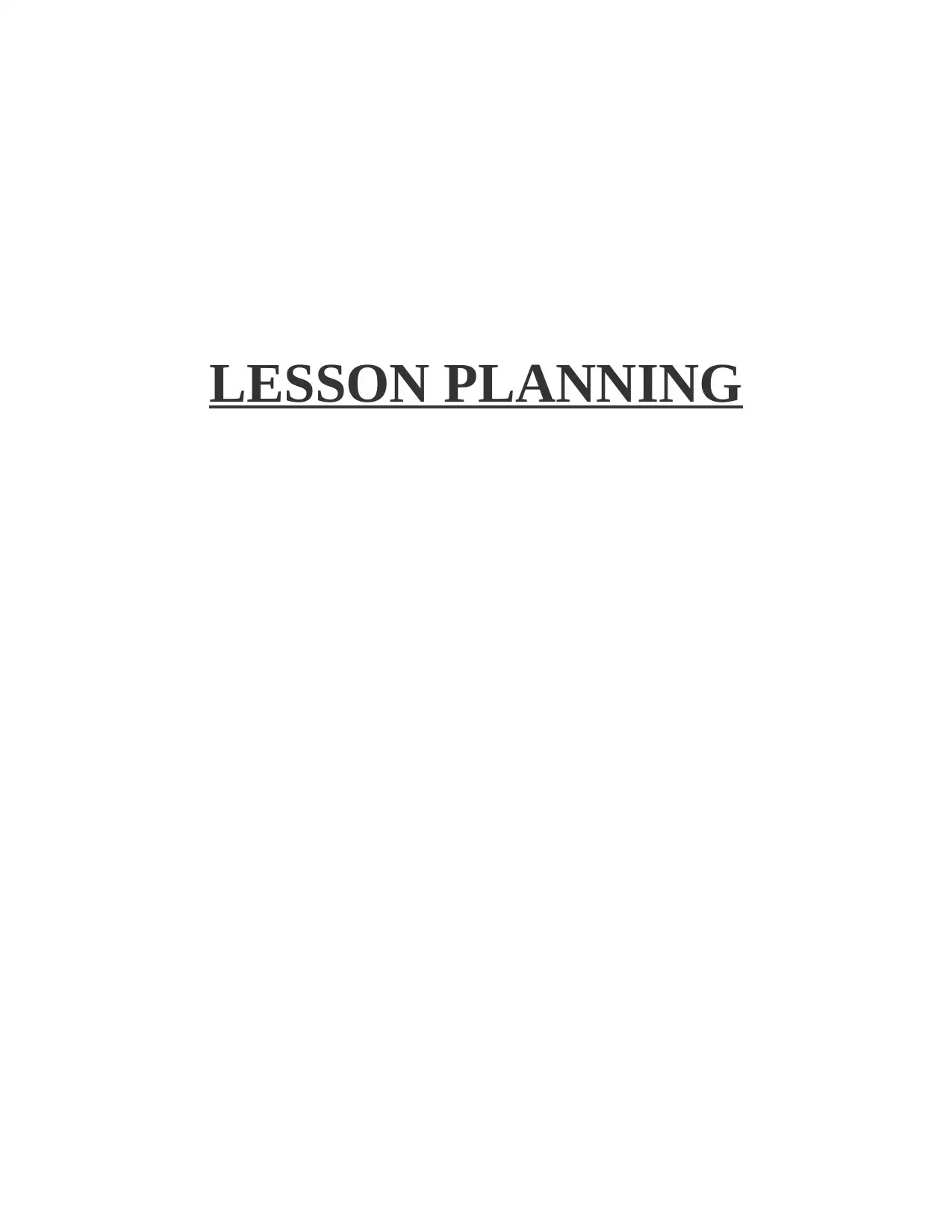
LESSON PLANNING
Secure Best Marks with AI Grader
Need help grading? Try our AI Grader for instant feedback on your assignments.
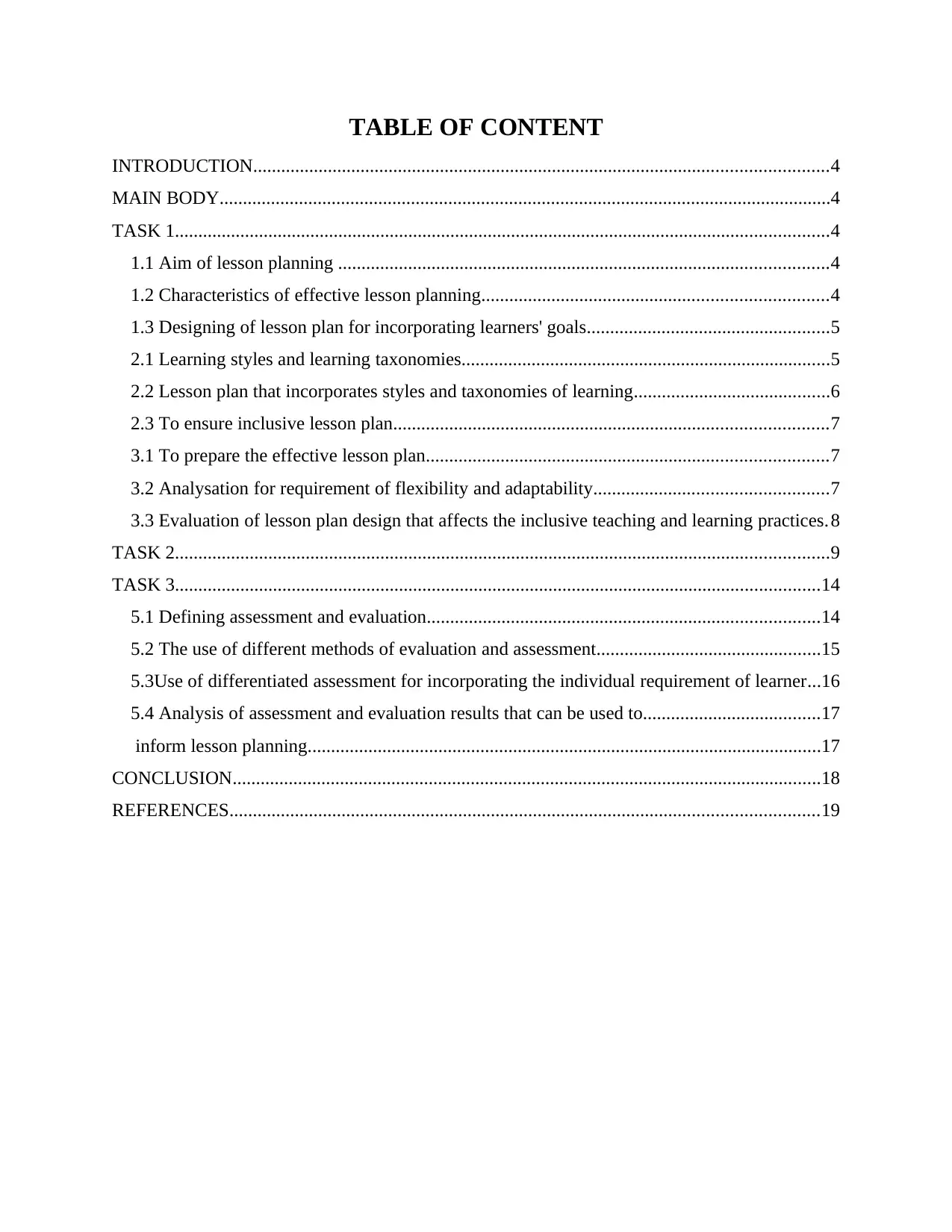
TABLE OF CONTENT
INTRODUCTION...........................................................................................................................4
MAIN BODY...................................................................................................................................4
TASK 1............................................................................................................................................4
1.1 Aim of lesson planning .........................................................................................................4
1.2 Characteristics of effective lesson planning..........................................................................4
1.3 Designing of lesson plan for incorporating learners' goals....................................................5
2.1 Learning styles and learning taxonomies...............................................................................5
2.2 Lesson plan that incorporates styles and taxonomies of learning..........................................6
2.3 To ensure inclusive lesson plan.............................................................................................7
3.1 To prepare the effective lesson plan......................................................................................7
3.2 Analysation for requirement of flexibility and adaptability..................................................7
3.3 Evaluation of lesson plan design that affects the inclusive teaching and learning practices. 8
TASK 2............................................................................................................................................9
TASK 3..........................................................................................................................................14
5.1 Defining assessment and evaluation....................................................................................14
5.2 The use of different methods of evaluation and assessment................................................15
5.3Use of differentiated assessment for incorporating the individual requirement of learner...16
5.4 Analysis of assessment and evaluation results that can be used to......................................17
inform lesson planning..............................................................................................................17
CONCLUSION..............................................................................................................................18
REFERENCES..............................................................................................................................19
INTRODUCTION...........................................................................................................................4
MAIN BODY...................................................................................................................................4
TASK 1............................................................................................................................................4
1.1 Aim of lesson planning .........................................................................................................4
1.2 Characteristics of effective lesson planning..........................................................................4
1.3 Designing of lesson plan for incorporating learners' goals....................................................5
2.1 Learning styles and learning taxonomies...............................................................................5
2.2 Lesson plan that incorporates styles and taxonomies of learning..........................................6
2.3 To ensure inclusive lesson plan.............................................................................................7
3.1 To prepare the effective lesson plan......................................................................................7
3.2 Analysation for requirement of flexibility and adaptability..................................................7
3.3 Evaluation of lesson plan design that affects the inclusive teaching and learning practices. 8
TASK 2............................................................................................................................................9
TASK 3..........................................................................................................................................14
5.1 Defining assessment and evaluation....................................................................................14
5.2 The use of different methods of evaluation and assessment................................................15
5.3Use of differentiated assessment for incorporating the individual requirement of learner...16
5.4 Analysis of assessment and evaluation results that can be used to......................................17
inform lesson planning..............................................................................................................17
CONCLUSION..............................................................................................................................18
REFERENCES..............................................................................................................................19

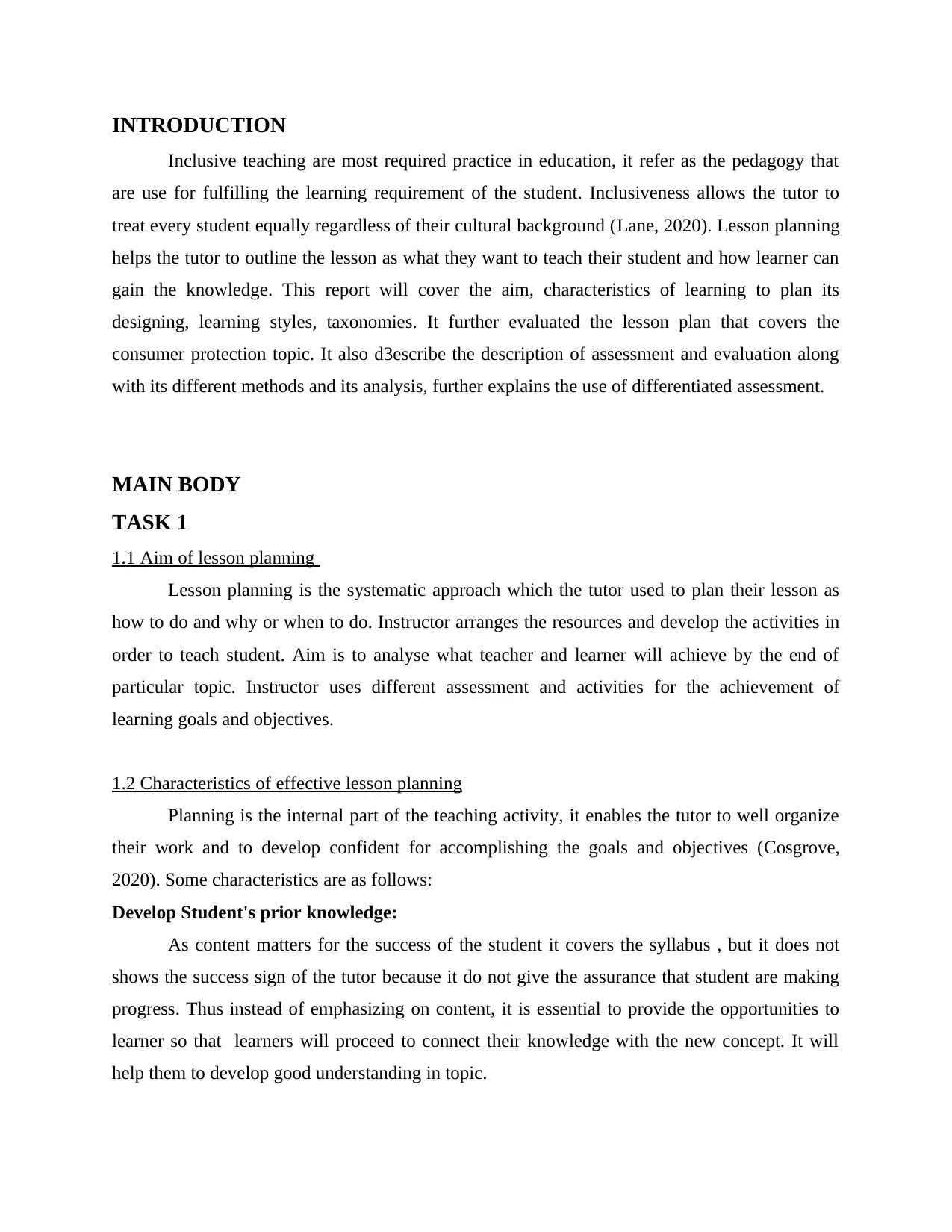
INTRODUCTION
Inclusive teaching are most required practice in education, it refer as the pedagogy that
are use for fulfilling the learning requirement of the student. Inclusiveness allows the tutor to
treat every student equally regardless of their cultural background (Lane, 2020). Lesson planning
helps the tutor to outline the lesson as what they want to teach their student and how learner can
gain the knowledge. This report will cover the aim, characteristics of learning to plan its
designing, learning styles, taxonomies. It further evaluated the lesson plan that covers the
consumer protection topic. It also d3escribe the description of assessment and evaluation along
with its different methods and its analysis, further explains the use of differentiated assessment.
MAIN BODY
TASK 1
1.1 Aim of lesson planning
Lesson planning is the systematic approach which the tutor used to plan their lesson as
how to do and why or when to do. Instructor arranges the resources and develop the activities in
order to teach student. Aim is to analyse what teacher and learner will achieve by the end of
particular topic. Instructor uses different assessment and activities for the achievement of
learning goals and objectives.
1.2 Characteristics of effective lesson planning
Planning is the internal part of the teaching activity, it enables the tutor to well organize
their work and to develop confident for accomplishing the goals and objectives (Cosgrove,
2020). Some characteristics are as follows:
Develop Student's prior knowledge:
As content matters for the success of the student it covers the syllabus , but it does not
shows the success sign of the tutor because it do not give the assurance that student are making
progress. Thus instead of emphasizing on content, it is essential to provide the opportunities to
learner so that learners will proceed to connect their knowledge with the new concept. It will
help them to develop good understanding in topic.
Inclusive teaching are most required practice in education, it refer as the pedagogy that
are use for fulfilling the learning requirement of the student. Inclusiveness allows the tutor to
treat every student equally regardless of their cultural background (Lane, 2020). Lesson planning
helps the tutor to outline the lesson as what they want to teach their student and how learner can
gain the knowledge. This report will cover the aim, characteristics of learning to plan its
designing, learning styles, taxonomies. It further evaluated the lesson plan that covers the
consumer protection topic. It also d3escribe the description of assessment and evaluation along
with its different methods and its analysis, further explains the use of differentiated assessment.
MAIN BODY
TASK 1
1.1 Aim of lesson planning
Lesson planning is the systematic approach which the tutor used to plan their lesson as
how to do and why or when to do. Instructor arranges the resources and develop the activities in
order to teach student. Aim is to analyse what teacher and learner will achieve by the end of
particular topic. Instructor uses different assessment and activities for the achievement of
learning goals and objectives.
1.2 Characteristics of effective lesson planning
Planning is the internal part of the teaching activity, it enables the tutor to well organize
their work and to develop confident for accomplishing the goals and objectives (Cosgrove,
2020). Some characteristics are as follows:
Develop Student's prior knowledge:
As content matters for the success of the student it covers the syllabus , but it does not
shows the success sign of the tutor because it do not give the assurance that student are making
progress. Thus instead of emphasizing on content, it is essential to provide the opportunities to
learner so that learners will proceed to connect their knowledge with the new concept. It will
help them to develop good understanding in topic.
Paraphrase This Document
Need a fresh take? Get an instant paraphrase of this document with our AI Paraphraser
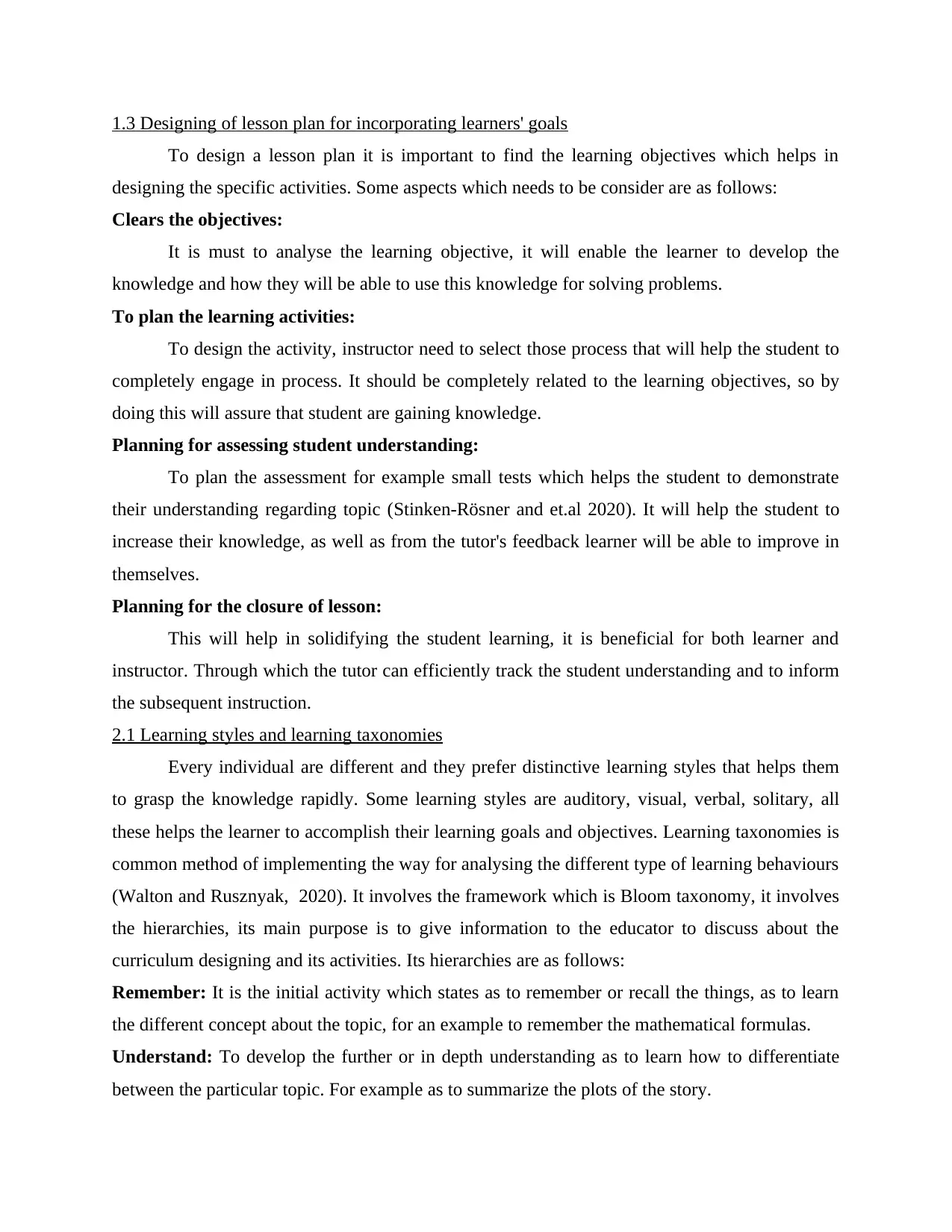
1.3 Designing of lesson plan for incorporating learners' goals
To design a lesson plan it is important to find the learning objectives which helps in
designing the specific activities. Some aspects which needs to be consider are as follows:
Clears the objectives:
It is must to analyse the learning objective, it will enable the learner to develop the
knowledge and how they will be able to use this knowledge for solving problems.
To plan the learning activities:
To design the activity, instructor need to select those process that will help the student to
completely engage in process. It should be completely related to the learning objectives, so by
doing this will assure that student are gaining knowledge.
Planning for assessing student understanding:
To plan the assessment for example small tests which helps the student to demonstrate
their understanding regarding topic (Stinken-Rösner and et.al 2020). It will help the student to
increase their knowledge, as well as from the tutor's feedback learner will be able to improve in
themselves.
Planning for the closure of lesson:
This will help in solidifying the student learning, it is beneficial for both learner and
instructor. Through which the tutor can efficiently track the student understanding and to inform
the subsequent instruction.
2.1 Learning styles and learning taxonomies
Every individual are different and they prefer distinctive learning styles that helps them
to grasp the knowledge rapidly. Some learning styles are auditory, visual, verbal, solitary, all
these helps the learner to accomplish their learning goals and objectives. Learning taxonomies is
common method of implementing the way for analysing the different type of learning behaviours
(Walton and Rusznyak, 2020). It involves the framework which is Bloom taxonomy, it involves
the hierarchies, its main purpose is to give information to the educator to discuss about the
curriculum designing and its activities. Its hierarchies are as follows:
Remember: It is the initial activity which states as to remember or recall the things, as to learn
the different concept about the topic, for an example to remember the mathematical formulas.
Understand: To develop the further or in depth understanding as to learn how to differentiate
between the particular topic. For example as to summarize the plots of the story.
To design a lesson plan it is important to find the learning objectives which helps in
designing the specific activities. Some aspects which needs to be consider are as follows:
Clears the objectives:
It is must to analyse the learning objective, it will enable the learner to develop the
knowledge and how they will be able to use this knowledge for solving problems.
To plan the learning activities:
To design the activity, instructor need to select those process that will help the student to
completely engage in process. It should be completely related to the learning objectives, so by
doing this will assure that student are gaining knowledge.
Planning for assessing student understanding:
To plan the assessment for example small tests which helps the student to demonstrate
their understanding regarding topic (Stinken-Rösner and et.al 2020). It will help the student to
increase their knowledge, as well as from the tutor's feedback learner will be able to improve in
themselves.
Planning for the closure of lesson:
This will help in solidifying the student learning, it is beneficial for both learner and
instructor. Through which the tutor can efficiently track the student understanding and to inform
the subsequent instruction.
2.1 Learning styles and learning taxonomies
Every individual are different and they prefer distinctive learning styles that helps them
to grasp the knowledge rapidly. Some learning styles are auditory, visual, verbal, solitary, all
these helps the learner to accomplish their learning goals and objectives. Learning taxonomies is
common method of implementing the way for analysing the different type of learning behaviours
(Walton and Rusznyak, 2020). It involves the framework which is Bloom taxonomy, it involves
the hierarchies, its main purpose is to give information to the educator to discuss about the
curriculum designing and its activities. Its hierarchies are as follows:
Remember: It is the initial activity which states as to remember or recall the things, as to learn
the different concept about the topic, for an example to remember the mathematical formulas.
Understand: To develop the further or in depth understanding as to learn how to differentiate
between the particular topic. For example as to summarize the plots of the story.

Apply: Apply the knowledge to solve the problems, therefore it is important to clears all doubts,
so that it will do not cause problems further. For an example to learn the formulas that will
applying further to solve the problem.
Analyse: In this analysis stage, it required to develop connectivity between ideas, as to evaluate,
discuss, test the topic. For an example to analyse why this equipment is not working efficiently.
Evaluate: Appraise, argue, compare it will help in making decision, for an example to interpret
the benefits of understanding physics laws.
Create: It is the last stage of the pyramid that refer as to use the knowledge for developing new
solution for solving the old problems.
2.2 Lesson plan that incorporates styles and taxonomies of learning
It is important that the lesson plan ensures the progress of the student, it can be
understood with the help of VARK framework-
VARK is a efficient framework, that is based on the human expression concept and it is used for
usually four types of learner. Its factors are:
Visual: In this student prefer the learning mode by using charts, graphs and projector
representation. It is efficient and beneficial as it helps in clearing all doubts and enable the
learner to develop in depth knowledge.
Auditory: It involves the spoken process, and audio formats, as some student prefer to learn by
listening lesson audio (Boussakssou, Hssina and Erittali, 2020). It can be beneficial for the
student who are disable.
Read and write: It is the most common learning styles, tutor use the boards for displaying the
information, through which the learner will easily understand concept and also with this they will
be able to effectively write their academic examination.
Kinaesthetic: In this students learn efficiently from hands on various learning opportunities,
instructor can proceed to give task to the student as to develop some poster, it will be ebneficial
for enhancing their knowledge.
so that it will do not cause problems further. For an example to learn the formulas that will
applying further to solve the problem.
Analyse: In this analysis stage, it required to develop connectivity between ideas, as to evaluate,
discuss, test the topic. For an example to analyse why this equipment is not working efficiently.
Evaluate: Appraise, argue, compare it will help in making decision, for an example to interpret
the benefits of understanding physics laws.
Create: It is the last stage of the pyramid that refer as to use the knowledge for developing new
solution for solving the old problems.
2.2 Lesson plan that incorporates styles and taxonomies of learning
It is important that the lesson plan ensures the progress of the student, it can be
understood with the help of VARK framework-
VARK is a efficient framework, that is based on the human expression concept and it is used for
usually four types of learner. Its factors are:
Visual: In this student prefer the learning mode by using charts, graphs and projector
representation. It is efficient and beneficial as it helps in clearing all doubts and enable the
learner to develop in depth knowledge.
Auditory: It involves the spoken process, and audio formats, as some student prefer to learn by
listening lesson audio (Boussakssou, Hssina and Erittali, 2020). It can be beneficial for the
student who are disable.
Read and write: It is the most common learning styles, tutor use the boards for displaying the
information, through which the learner will easily understand concept and also with this they will
be able to effectively write their academic examination.
Kinaesthetic: In this students learn efficiently from hands on various learning opportunities,
instructor can proceed to give task to the student as to develop some poster, it will be ebneficial
for enhancing their knowledge.
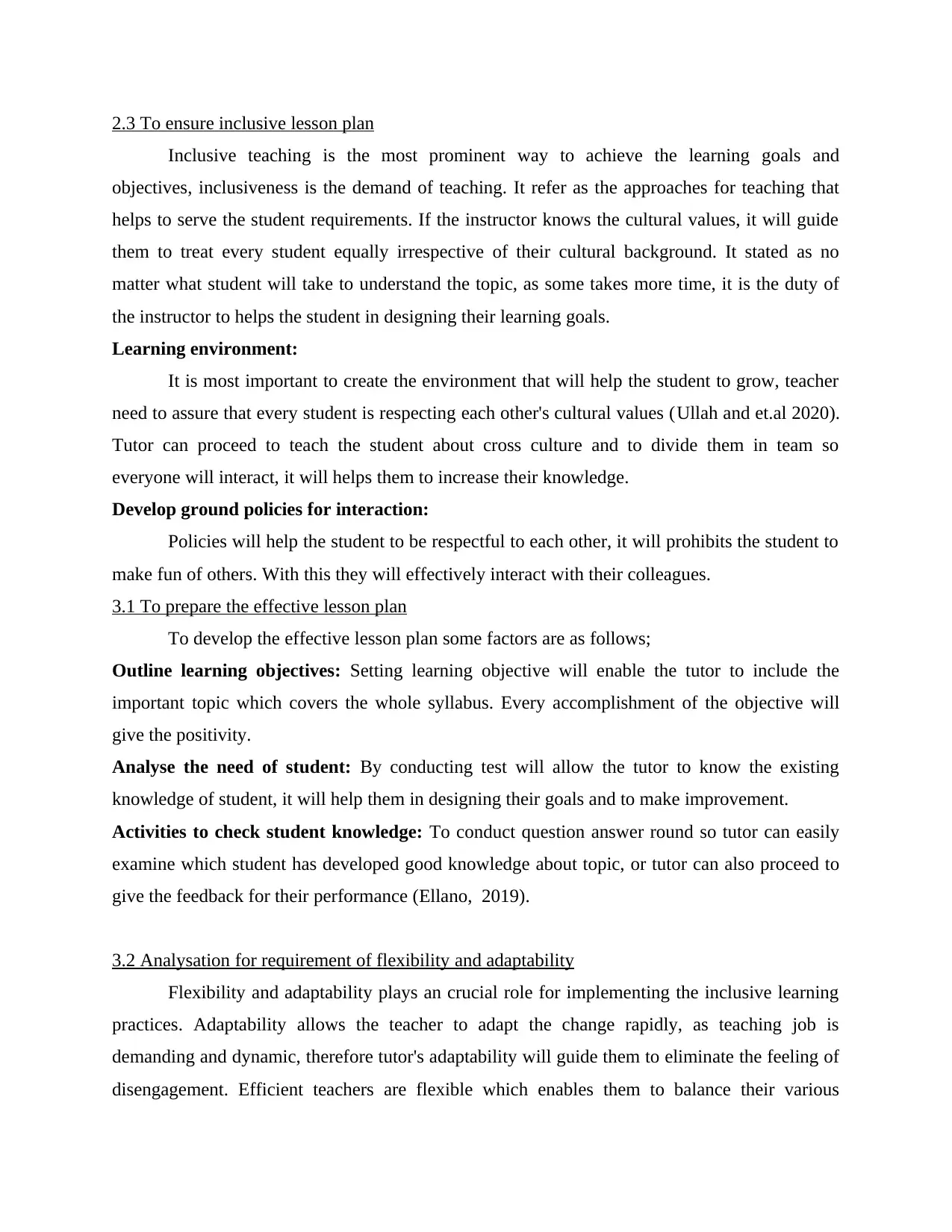
2.3 To ensure inclusive lesson plan
Inclusive teaching is the most prominent way to achieve the learning goals and
objectives, inclusiveness is the demand of teaching. It refer as the approaches for teaching that
helps to serve the student requirements. If the instructor knows the cultural values, it will guide
them to treat every student equally irrespective of their cultural background. It stated as no
matter what student will take to understand the topic, as some takes more time, it is the duty of
the instructor to helps the student in designing their learning goals.
Learning environment:
It is most important to create the environment that will help the student to grow, teacher
need to assure that every student is respecting each other's cultural values (Ullah and et.al 2020).
Tutor can proceed to teach the student about cross culture and to divide them in team so
everyone will interact, it will helps them to increase their knowledge.
Develop ground policies for interaction:
Policies will help the student to be respectful to each other, it will prohibits the student to
make fun of others. With this they will effectively interact with their colleagues.
3.1 To prepare the effective lesson plan
To develop the effective lesson plan some factors are as follows;
Outline learning objectives: Setting learning objective will enable the tutor to include the
important topic which covers the whole syllabus. Every accomplishment of the objective will
give the positivity.
Analyse the need of student: By conducting test will allow the tutor to know the existing
knowledge of student, it will help them in designing their goals and to make improvement.
Activities to check student knowledge: To conduct question answer round so tutor can easily
examine which student has developed good knowledge about topic, or tutor can also proceed to
give the feedback for their performance (Ellano, 2019).
3.2 Analysation for requirement of flexibility and adaptability
Flexibility and adaptability plays an crucial role for implementing the inclusive learning
practices. Adaptability allows the teacher to adapt the change rapidly, as teaching job is
demanding and dynamic, therefore tutor's adaptability will guide them to eliminate the feeling of
disengagement. Efficient teachers are flexible which enables them to balance their various
Inclusive teaching is the most prominent way to achieve the learning goals and
objectives, inclusiveness is the demand of teaching. It refer as the approaches for teaching that
helps to serve the student requirements. If the instructor knows the cultural values, it will guide
them to treat every student equally irrespective of their cultural background. It stated as no
matter what student will take to understand the topic, as some takes more time, it is the duty of
the instructor to helps the student in designing their learning goals.
Learning environment:
It is most important to create the environment that will help the student to grow, teacher
need to assure that every student is respecting each other's cultural values (Ullah and et.al 2020).
Tutor can proceed to teach the student about cross culture and to divide them in team so
everyone will interact, it will helps them to increase their knowledge.
Develop ground policies for interaction:
Policies will help the student to be respectful to each other, it will prohibits the student to
make fun of others. With this they will effectively interact with their colleagues.
3.1 To prepare the effective lesson plan
To develop the effective lesson plan some factors are as follows;
Outline learning objectives: Setting learning objective will enable the tutor to include the
important topic which covers the whole syllabus. Every accomplishment of the objective will
give the positivity.
Analyse the need of student: By conducting test will allow the tutor to know the existing
knowledge of student, it will help them in designing their goals and to make improvement.
Activities to check student knowledge: To conduct question answer round so tutor can easily
examine which student has developed good knowledge about topic, or tutor can also proceed to
give the feedback for their performance (Ellano, 2019).
3.2 Analysation for requirement of flexibility and adaptability
Flexibility and adaptability plays an crucial role for implementing the inclusive learning
practices. Adaptability allows the teacher to adapt the change rapidly, as teaching job is
demanding and dynamic, therefore tutor's adaptability will guide them to eliminate the feeling of
disengagement. Efficient teachers are flexible which enables them to balance their various
Secure Best Marks with AI Grader
Need help grading? Try our AI Grader for instant feedback on your assignments.
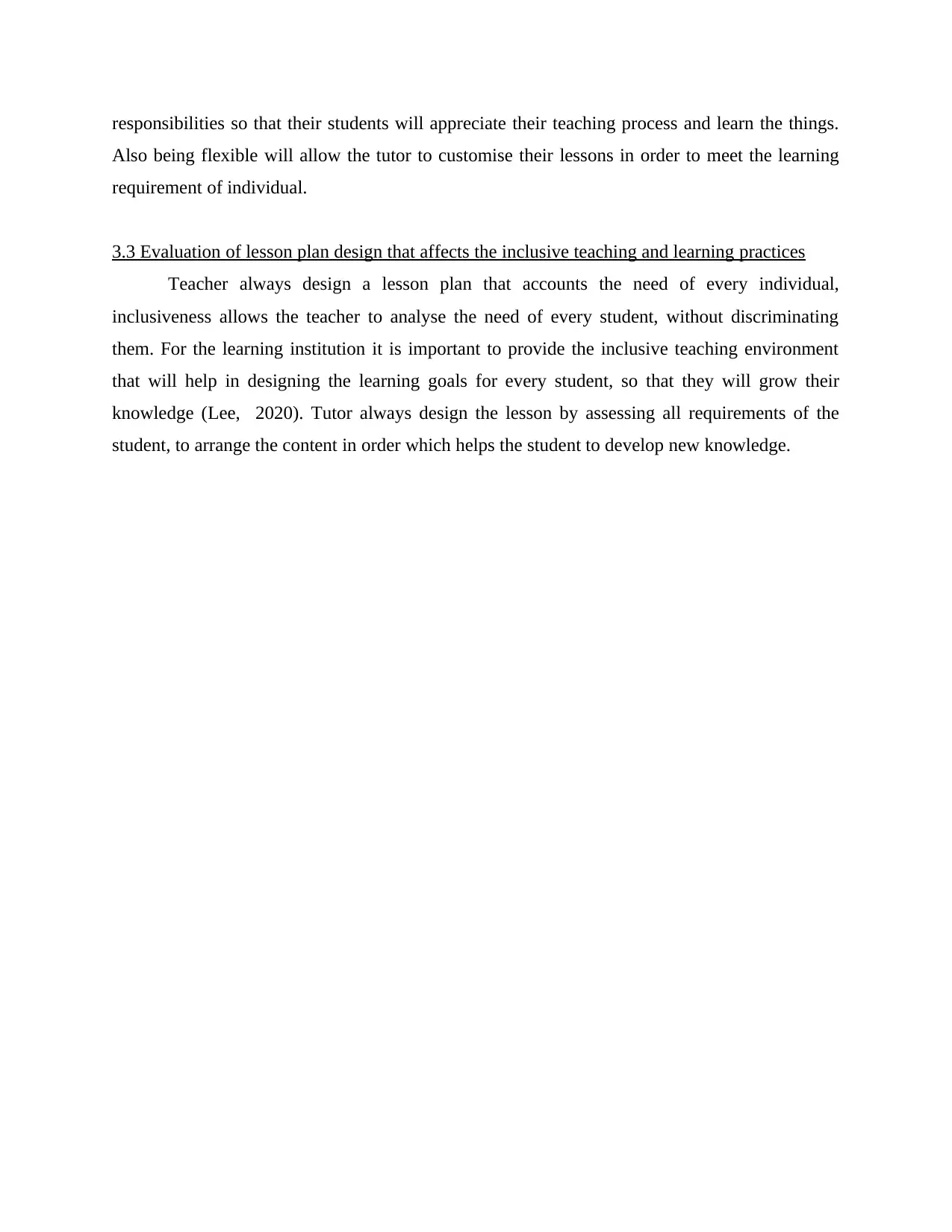
responsibilities so that their students will appreciate their teaching process and learn the things.
Also being flexible will allow the tutor to customise their lessons in order to meet the learning
requirement of individual.
3.3 Evaluation of lesson plan design that affects the inclusive teaching and learning practices
Teacher always design a lesson plan that accounts the need of every individual,
inclusiveness allows the teacher to analyse the need of every student, without discriminating
them. For the learning institution it is important to provide the inclusive teaching environment
that will help in designing the learning goals for every student, so that they will grow their
knowledge (Lee, 2020). Tutor always design the lesson by assessing all requirements of the
student, to arrange the content in order which helps the student to develop new knowledge.
Also being flexible will allow the tutor to customise their lessons in order to meet the learning
requirement of individual.
3.3 Evaluation of lesson plan design that affects the inclusive teaching and learning practices
Teacher always design a lesson plan that accounts the need of every individual,
inclusiveness allows the teacher to analyse the need of every student, without discriminating
them. For the learning institution it is important to provide the inclusive teaching environment
that will help in designing the learning goals for every student, so that they will grow their
knowledge (Lee, 2020). Tutor always design the lesson by assessing all requirements of the
student, to arrange the content in order which helps the student to develop new knowledge.
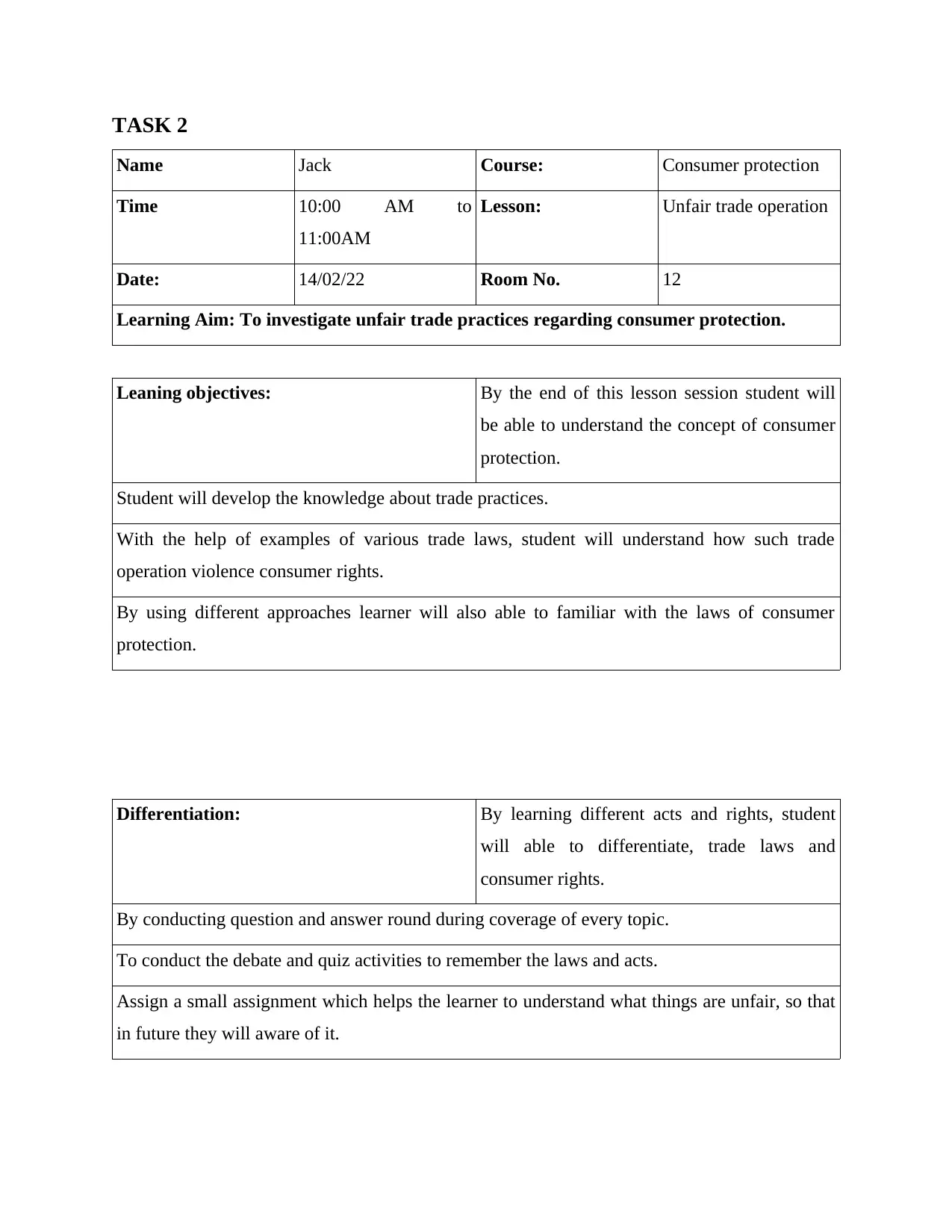
TASK 2
Name Jack Course: Consumer protection
Time 10:00 AM to
11:00AM
Lesson: Unfair trade operation
Date: 14/02/22 Room No. 12
Learning Aim: To investigate unfair trade practices regarding consumer protection.
Leaning objectives: By the end of this lesson session student will
be able to understand the concept of consumer
protection.
Student will develop the knowledge about trade practices.
With the help of examples of various trade laws, student will understand how such trade
operation violence consumer rights.
By using different approaches learner will also able to familiar with the laws of consumer
protection.
Differentiation: By learning different acts and rights, student
will able to differentiate, trade laws and
consumer rights.
By conducting question and answer round during coverage of every topic.
To conduct the debate and quiz activities to remember the laws and acts.
Assign a small assignment which helps the learner to understand what things are unfair, so that
in future they will aware of it.
Name Jack Course: Consumer protection
Time 10:00 AM to
11:00AM
Lesson: Unfair trade operation
Date: 14/02/22 Room No. 12
Learning Aim: To investigate unfair trade practices regarding consumer protection.
Leaning objectives: By the end of this lesson session student will
be able to understand the concept of consumer
protection.
Student will develop the knowledge about trade practices.
With the help of examples of various trade laws, student will understand how such trade
operation violence consumer rights.
By using different approaches learner will also able to familiar with the laws of consumer
protection.
Differentiation: By learning different acts and rights, student
will able to differentiate, trade laws and
consumer rights.
By conducting question and answer round during coverage of every topic.
To conduct the debate and quiz activities to remember the laws and acts.
Assign a small assignment which helps the learner to understand what things are unfair, so that
in future they will aware of it.
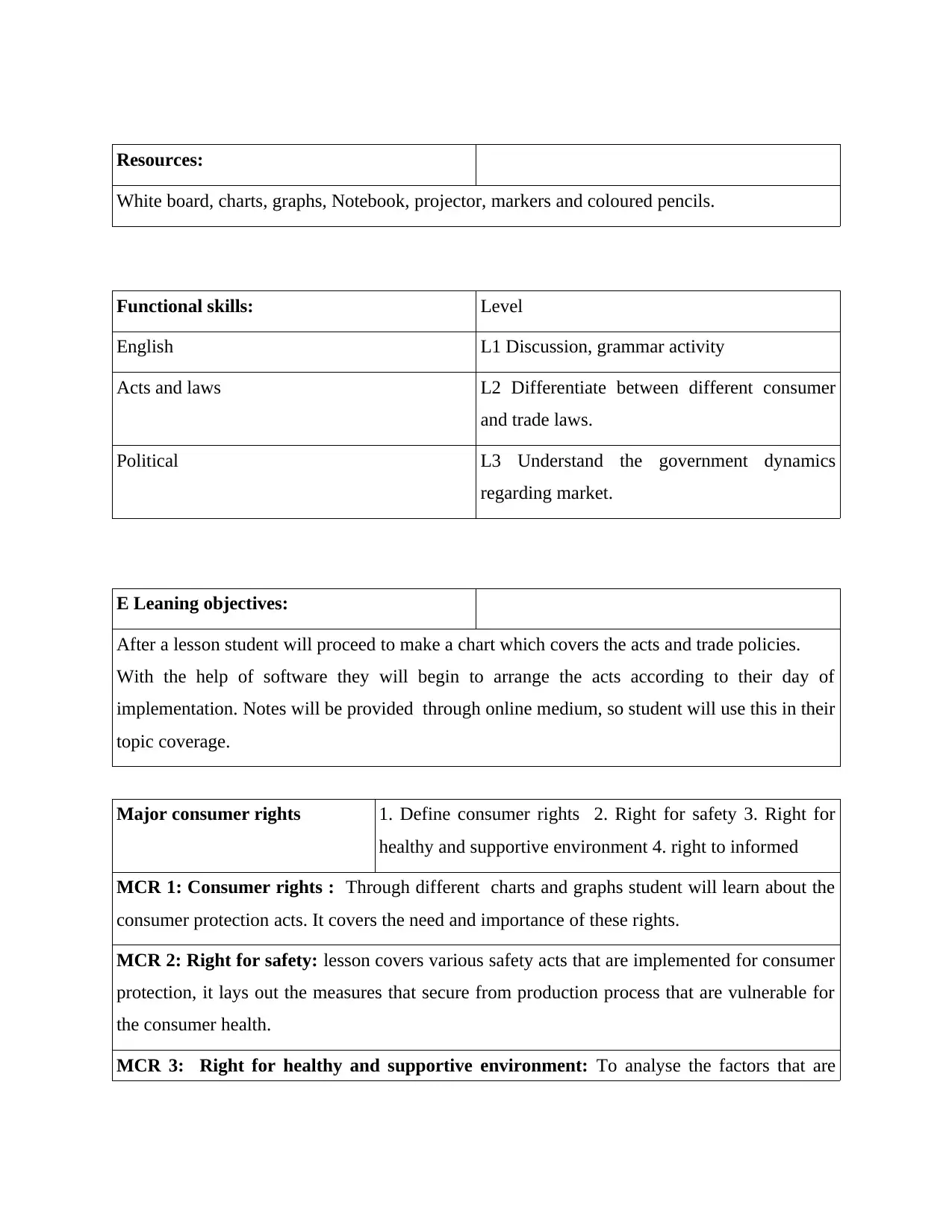
Resources:
White board, charts, graphs, Notebook, projector, markers and coloured pencils.
Functional skills: Level
English L1 Discussion, grammar activity
Acts and laws L2 Differentiate between different consumer
and trade laws.
Political L3 Understand the government dynamics
regarding market.
E Leaning objectives:
After a lesson student will proceed to make a chart which covers the acts and trade policies.
With the help of software they will begin to arrange the acts according to their day of
implementation. Notes will be provided through online medium, so student will use this in their
topic coverage.
Major consumer rights 1. Define consumer rights 2. Right for safety 3. Right for
healthy and supportive environment 4. right to informed
MCR 1: Consumer rights : Through different charts and graphs student will learn about the
consumer protection acts. It covers the need and importance of these rights.
MCR 2: Right for safety: lesson covers various safety acts that are implemented for consumer
protection, it lays out the measures that secure from production process that are vulnerable for
the consumer health.
MCR 3: Right for healthy and supportive environment: To analyse the factors that are
White board, charts, graphs, Notebook, projector, markers and coloured pencils.
Functional skills: Level
English L1 Discussion, grammar activity
Acts and laws L2 Differentiate between different consumer
and trade laws.
Political L3 Understand the government dynamics
regarding market.
E Leaning objectives:
After a lesson student will proceed to make a chart which covers the acts and trade policies.
With the help of software they will begin to arrange the acts according to their day of
implementation. Notes will be provided through online medium, so student will use this in their
topic coverage.
Major consumer rights 1. Define consumer rights 2. Right for safety 3. Right for
healthy and supportive environment 4. right to informed
MCR 1: Consumer rights : Through different charts and graphs student will learn about the
consumer protection acts. It covers the need and importance of these rights.
MCR 2: Right for safety: lesson covers various safety acts that are implemented for consumer
protection, it lays out the measures that secure from production process that are vulnerable for
the consumer health.
MCR 3: Right for healthy and supportive environment: To analyse the factors that are
Paraphrase This Document
Need a fresh take? Get an instant paraphrase of this document with our AI Paraphraser
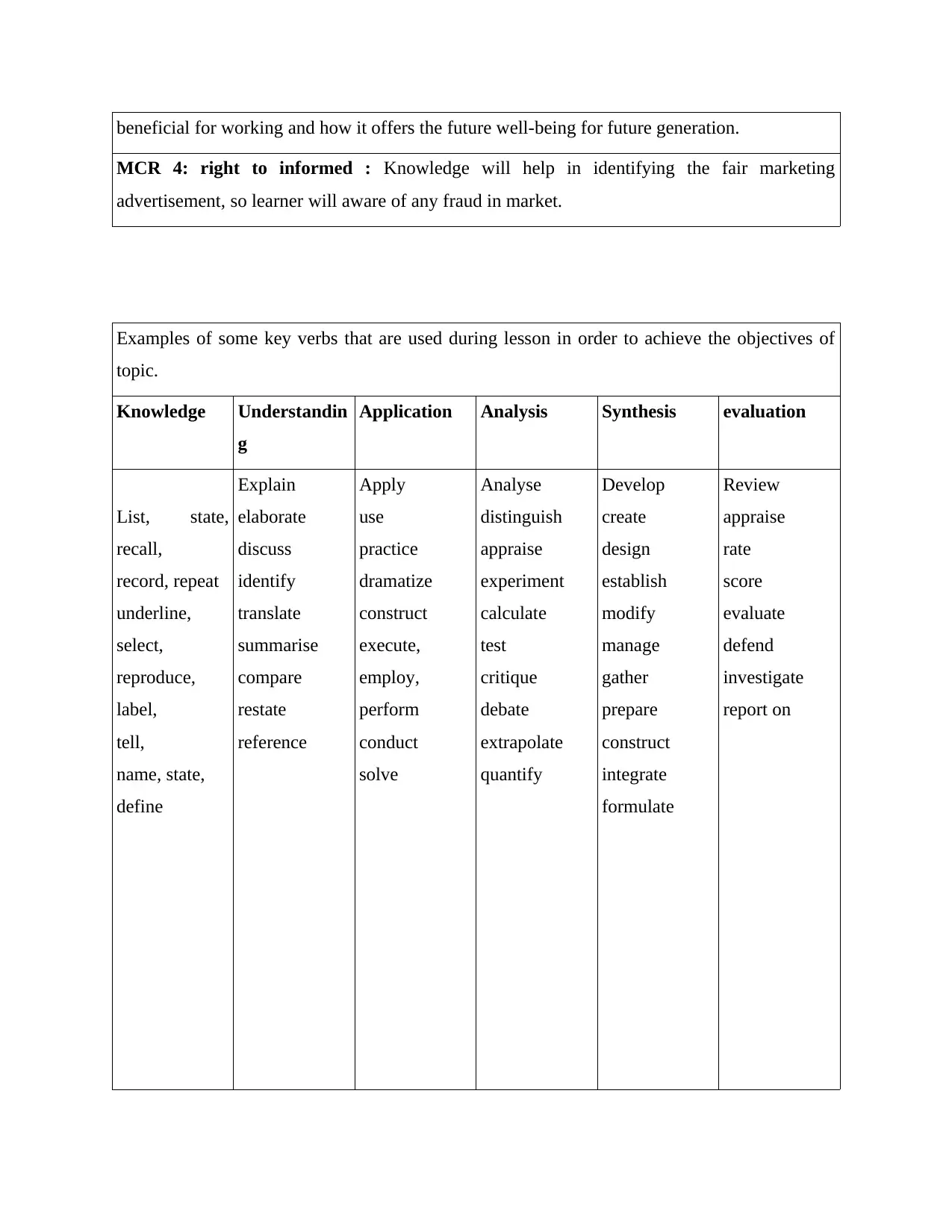
beneficial for working and how it offers the future well-being for future generation.
MCR 4: right to informed : Knowledge will help in identifying the fair marketing
advertisement, so learner will aware of any fraud in market.
Examples of some key verbs that are used during lesson in order to achieve the objectives of
topic.
Knowledge Understandin
g
Application Analysis Synthesis evaluation
List, state,
recall,
record, repeat
underline,
select,
reproduce,
label,
tell,
name, state,
define
Explain
elaborate
discuss
identify
translate
summarise
compare
restate
reference
Apply
use
practice
dramatize
construct
execute,
employ,
perform
conduct
solve
Analyse
distinguish
appraise
experiment
calculate
test
critique
debate
extrapolate
quantify
Develop
create
design
establish
modify
manage
gather
prepare
construct
integrate
formulate
Review
appraise
rate
score
evaluate
defend
investigate
report on
MCR 4: right to informed : Knowledge will help in identifying the fair marketing
advertisement, so learner will aware of any fraud in market.
Examples of some key verbs that are used during lesson in order to achieve the objectives of
topic.
Knowledge Understandin
g
Application Analysis Synthesis evaluation
List, state,
recall,
record, repeat
underline,
select,
reproduce,
label,
tell,
name, state,
define
Explain
elaborate
discuss
identify
translate
summarise
compare
restate
reference
Apply
use
practice
dramatize
construct
execute,
employ,
perform
conduct
solve
Analyse
distinguish
appraise
experiment
calculate
test
critique
debate
extrapolate
quantify
Develop
create
design
establish
modify
manage
gather
prepare
construct
integrate
formulate
Review
appraise
rate
score
evaluate
defend
investigate
report on
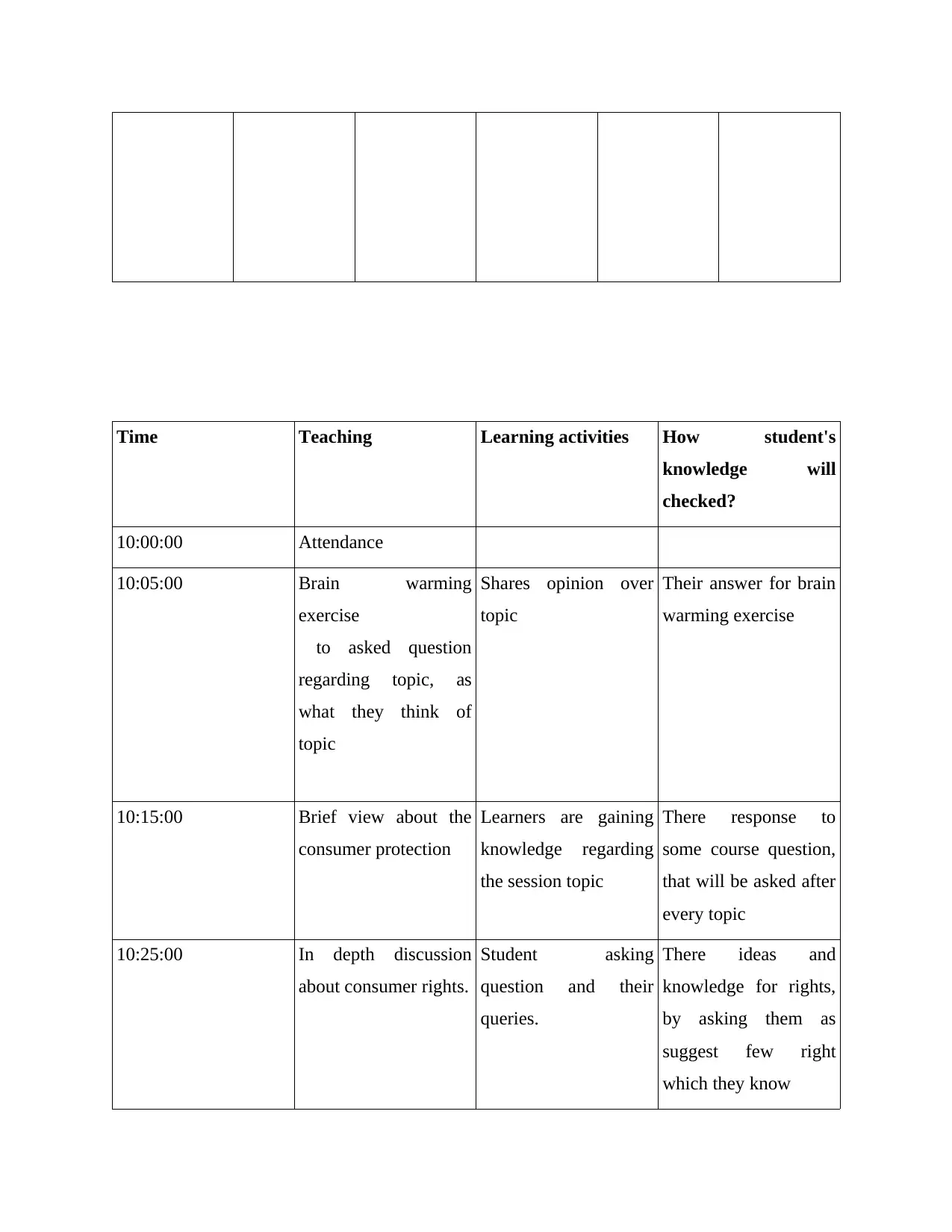
Time Teaching Learning activities How student's
knowledge will
checked?
10:00:00 Attendance
10:05:00 Brain warming
exercise
to asked question
regarding topic, as
what they think of
topic
Shares opinion over
topic
Their answer for brain
warming exercise
10:15:00 Brief view about the
consumer protection
Learners are gaining
knowledge regarding
the session topic
There response to
some course question,
that will be asked after
every topic
10:25:00 In depth discussion
about consumer rights.
Student asking
question and their
queries.
There ideas and
knowledge for rights,
by asking them as
suggest few right
which they know
knowledge will
checked?
10:00:00 Attendance
10:05:00 Brain warming
exercise
to asked question
regarding topic, as
what they think of
topic
Shares opinion over
topic
Their answer for brain
warming exercise
10:15:00 Brief view about the
consumer protection
Learners are gaining
knowledge regarding
the session topic
There response to
some course question,
that will be asked after
every topic
10:25:00 In depth discussion
about consumer rights.
Student asking
question and their
queries.
There ideas and
knowledge for rights,
by asking them as
suggest few right
which they know
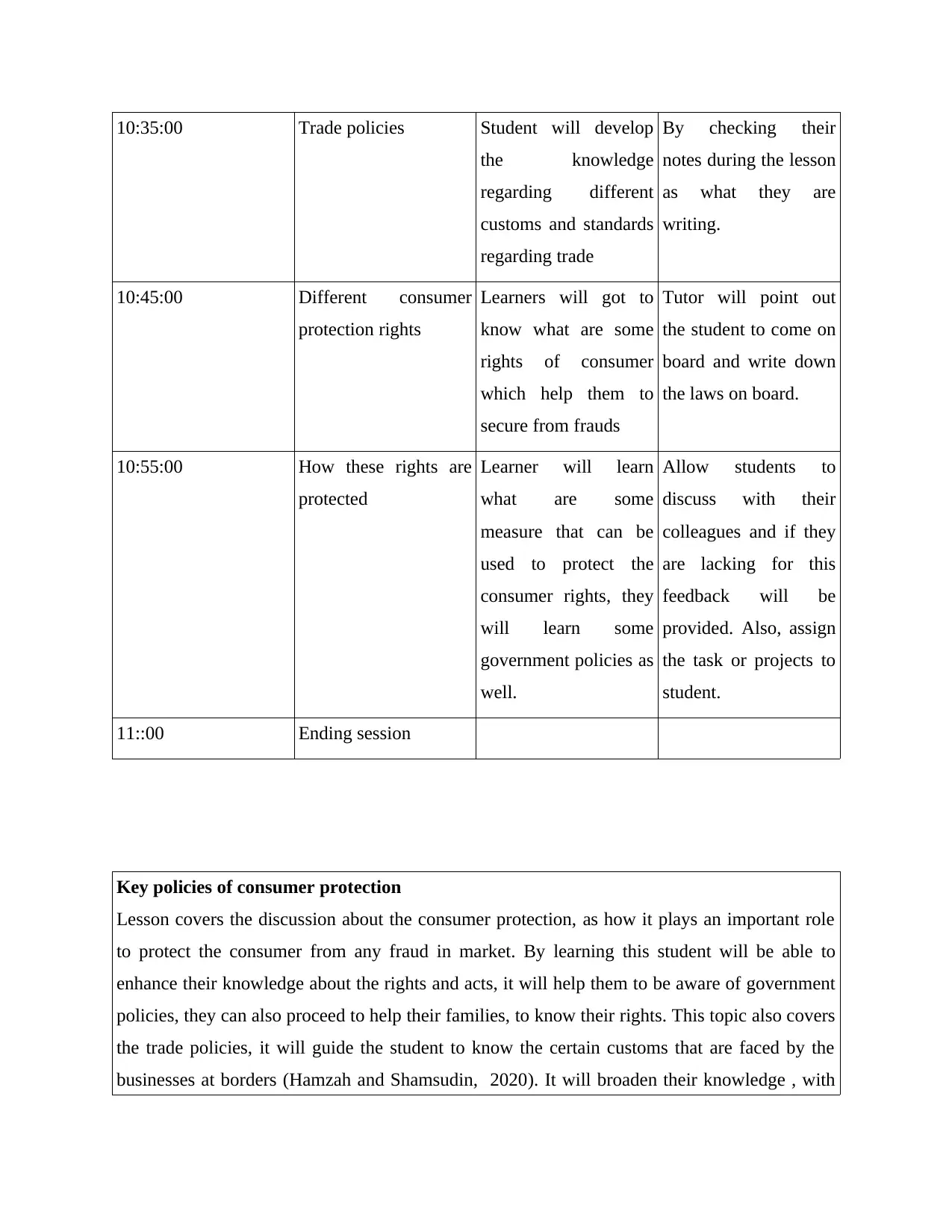
10:35:00 Trade policies Student will develop
the knowledge
regarding different
customs and standards
regarding trade
By checking their
notes during the lesson
as what they are
writing.
10:45:00 Different consumer
protection rights
Learners will got to
know what are some
rights of consumer
which help them to
secure from frauds
Tutor will point out
the student to come on
board and write down
the laws on board.
10:55:00 How these rights are
protected
Learner will learn
what are some
measure that can be
used to protect the
consumer rights, they
will learn some
government policies as
well.
Allow students to
discuss with their
colleagues and if they
are lacking for this
feedback will be
provided. Also, assign
the task or projects to
student.
11::00 Ending session
Key policies of consumer protection
Lesson covers the discussion about the consumer protection, as how it plays an important role
to protect the consumer from any fraud in market. By learning this student will be able to
enhance their knowledge about the rights and acts, it will help them to be aware of government
policies, they can also proceed to help their families, to know their rights. This topic also covers
the trade policies, it will guide the student to know the certain customs that are faced by the
businesses at borders (Hamzah and Shamsudin, 2020). It will broaden their knowledge , with
the knowledge
regarding different
customs and standards
regarding trade
By checking their
notes during the lesson
as what they are
writing.
10:45:00 Different consumer
protection rights
Learners will got to
know what are some
rights of consumer
which help them to
secure from frauds
Tutor will point out
the student to come on
board and write down
the laws on board.
10:55:00 How these rights are
protected
Learner will learn
what are some
measure that can be
used to protect the
consumer rights, they
will learn some
government policies as
well.
Allow students to
discuss with their
colleagues and if they
are lacking for this
feedback will be
provided. Also, assign
the task or projects to
student.
11::00 Ending session
Key policies of consumer protection
Lesson covers the discussion about the consumer protection, as how it plays an important role
to protect the consumer from any fraud in market. By learning this student will be able to
enhance their knowledge about the rights and acts, it will help them to be aware of government
policies, they can also proceed to help their families, to know their rights. This topic also covers
the trade policies, it will guide the student to know the certain customs that are faced by the
businesses at borders (Hamzah and Shamsudin, 2020). It will broaden their knowledge , with
Secure Best Marks with AI Grader
Need help grading? Try our AI Grader for instant feedback on your assignments.
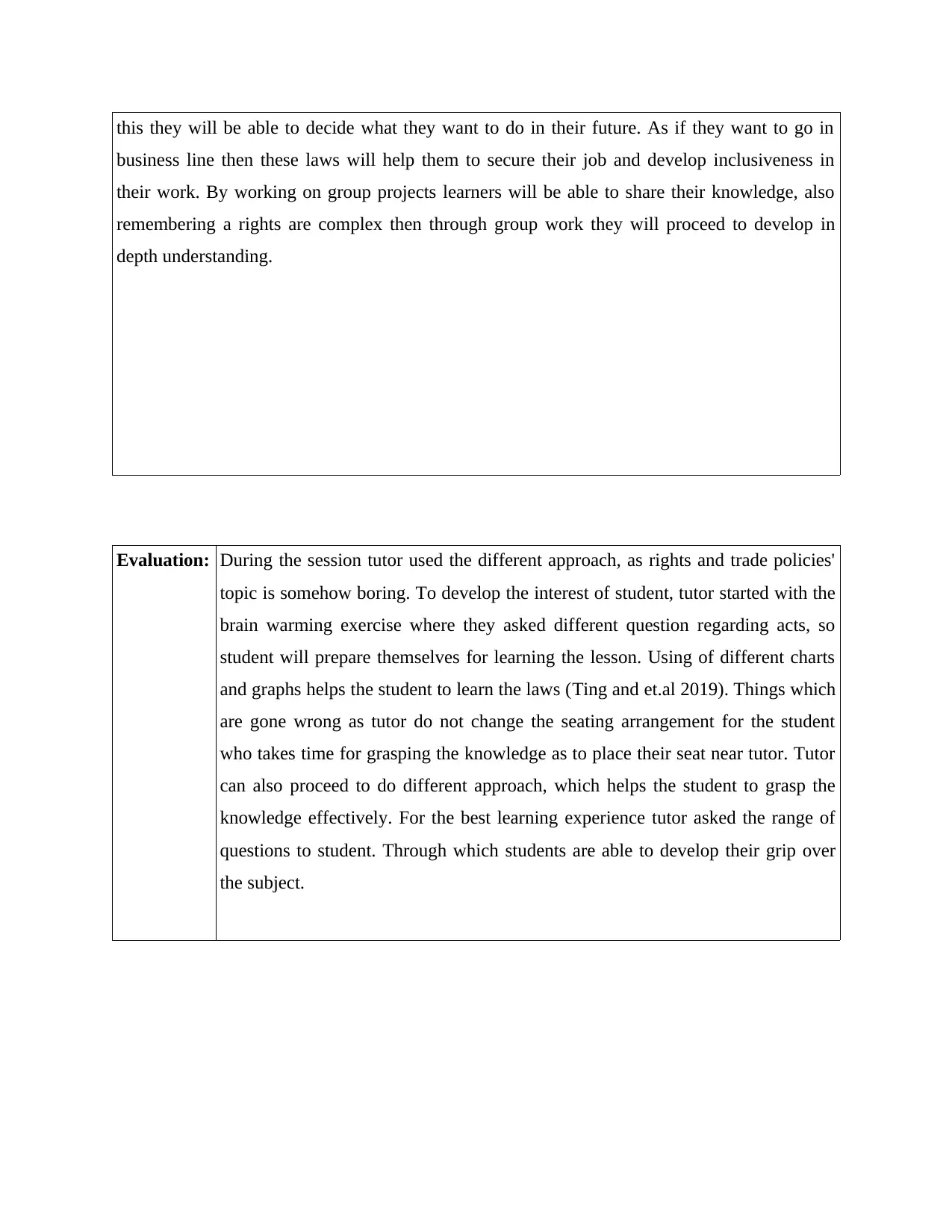
this they will be able to decide what they want to do in their future. As if they want to go in
business line then these laws will help them to secure their job and develop inclusiveness in
their work. By working on group projects learners will be able to share their knowledge, also
remembering a rights are complex then through group work they will proceed to develop in
depth understanding.
Evaluation: During the session tutor used the different approach, as rights and trade policies'
topic is somehow boring. To develop the interest of student, tutor started with the
brain warming exercise where they asked different question regarding acts, so
student will prepare themselves for learning the lesson. Using of different charts
and graphs helps the student to learn the laws (Ting and et.al 2019). Things which
are gone wrong as tutor do not change the seating arrangement for the student
who takes time for grasping the knowledge as to place their seat near tutor. Tutor
can also proceed to do different approach, which helps the student to grasp the
knowledge effectively. For the best learning experience tutor asked the range of
questions to student. Through which students are able to develop their grip over
the subject.
business line then these laws will help them to secure their job and develop inclusiveness in
their work. By working on group projects learners will be able to share their knowledge, also
remembering a rights are complex then through group work they will proceed to develop in
depth understanding.
Evaluation: During the session tutor used the different approach, as rights and trade policies'
topic is somehow boring. To develop the interest of student, tutor started with the
brain warming exercise where they asked different question regarding acts, so
student will prepare themselves for learning the lesson. Using of different charts
and graphs helps the student to learn the laws (Ting and et.al 2019). Things which
are gone wrong as tutor do not change the seating arrangement for the student
who takes time for grasping the knowledge as to place their seat near tutor. Tutor
can also proceed to do different approach, which helps the student to grasp the
knowledge effectively. For the best learning experience tutor asked the range of
questions to student. Through which students are able to develop their grip over
the subject.
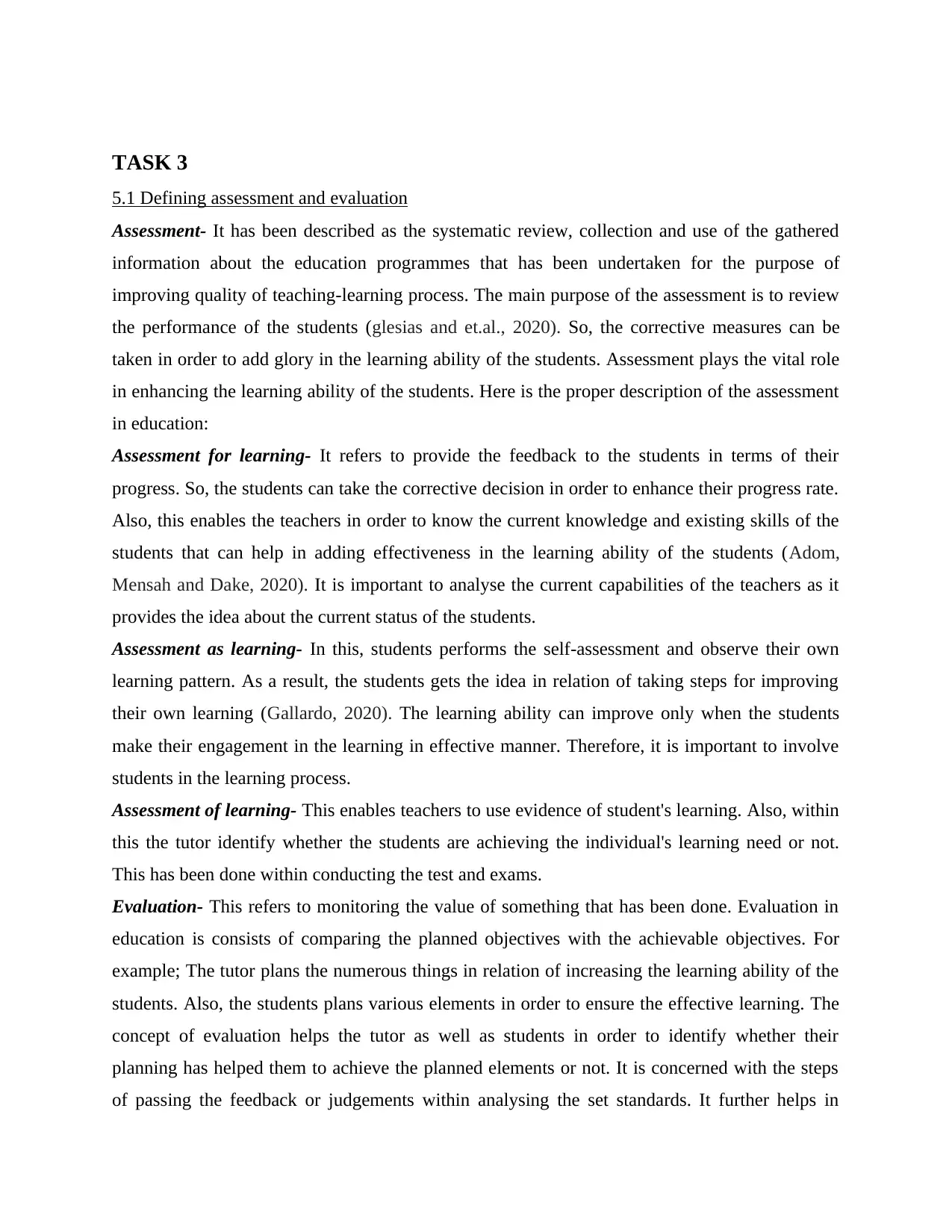
TASK 3
5.1 Defining assessment and evaluation
Assessment- It has been described as the systematic review, collection and use of the gathered
information about the education programmes that has been undertaken for the purpose of
improving quality of teaching-learning process. The main purpose of the assessment is to review
the performance of the students (glesias and et.al., 2020). So, the corrective measures can be
taken in order to add glory in the learning ability of the students. Assessment plays the vital role
in enhancing the learning ability of the students. Here is the proper description of the assessment
in education:
Assessment for learning- It refers to provide the feedback to the students in terms of their
progress. So, the students can take the corrective decision in order to enhance their progress rate.
Also, this enables the teachers in order to know the current knowledge and existing skills of the
students that can help in adding effectiveness in the learning ability of the students (Adom,
Mensah and Dake, 2020). It is important to analyse the current capabilities of the teachers as it
provides the idea about the current status of the students.
Assessment as learning- In this, students performs the self-assessment and observe their own
learning pattern. As a result, the students gets the idea in relation of taking steps for improving
their own learning (Gallardo, 2020). The learning ability can improve only when the students
make their engagement in the learning in effective manner. Therefore, it is important to involve
students in the learning process.
Assessment of learning- This enables teachers to use evidence of student's learning. Also, within
this the tutor identify whether the students are achieving the individual's learning need or not.
This has been done within conducting the test and exams.
Evaluation- This refers to monitoring the value of something that has been done. Evaluation in
education is consists of comparing the planned objectives with the achievable objectives. For
example; The tutor plans the numerous things in relation of increasing the learning ability of the
students. Also, the students plans various elements in order to ensure the effective learning. The
concept of evaluation helps the tutor as well as students in order to identify whether their
planning has helped them to achieve the planned elements or not. It is concerned with the steps
of passing the feedback or judgements within analysing the set standards. It further helps in
5.1 Defining assessment and evaluation
Assessment- It has been described as the systematic review, collection and use of the gathered
information about the education programmes that has been undertaken for the purpose of
improving quality of teaching-learning process. The main purpose of the assessment is to review
the performance of the students (glesias and et.al., 2020). So, the corrective measures can be
taken in order to add glory in the learning ability of the students. Assessment plays the vital role
in enhancing the learning ability of the students. Here is the proper description of the assessment
in education:
Assessment for learning- It refers to provide the feedback to the students in terms of their
progress. So, the students can take the corrective decision in order to enhance their progress rate.
Also, this enables the teachers in order to know the current knowledge and existing skills of the
students that can help in adding effectiveness in the learning ability of the students (Adom,
Mensah and Dake, 2020). It is important to analyse the current capabilities of the teachers as it
provides the idea about the current status of the students.
Assessment as learning- In this, students performs the self-assessment and observe their own
learning pattern. As a result, the students gets the idea in relation of taking steps for improving
their own learning (Gallardo, 2020). The learning ability can improve only when the students
make their engagement in the learning in effective manner. Therefore, it is important to involve
students in the learning process.
Assessment of learning- This enables teachers to use evidence of student's learning. Also, within
this the tutor identify whether the students are achieving the individual's learning need or not.
This has been done within conducting the test and exams.
Evaluation- This refers to monitoring the value of something that has been done. Evaluation in
education is consists of comparing the planned objectives with the achievable objectives. For
example; The tutor plans the numerous things in relation of increasing the learning ability of the
students. Also, the students plans various elements in order to ensure the effective learning. The
concept of evaluation helps the tutor as well as students in order to identify whether their
planning has helped them to achieve the planned elements or not. It is concerned with the steps
of passing the feedback or judgements within analysing the set standards. It further helps in
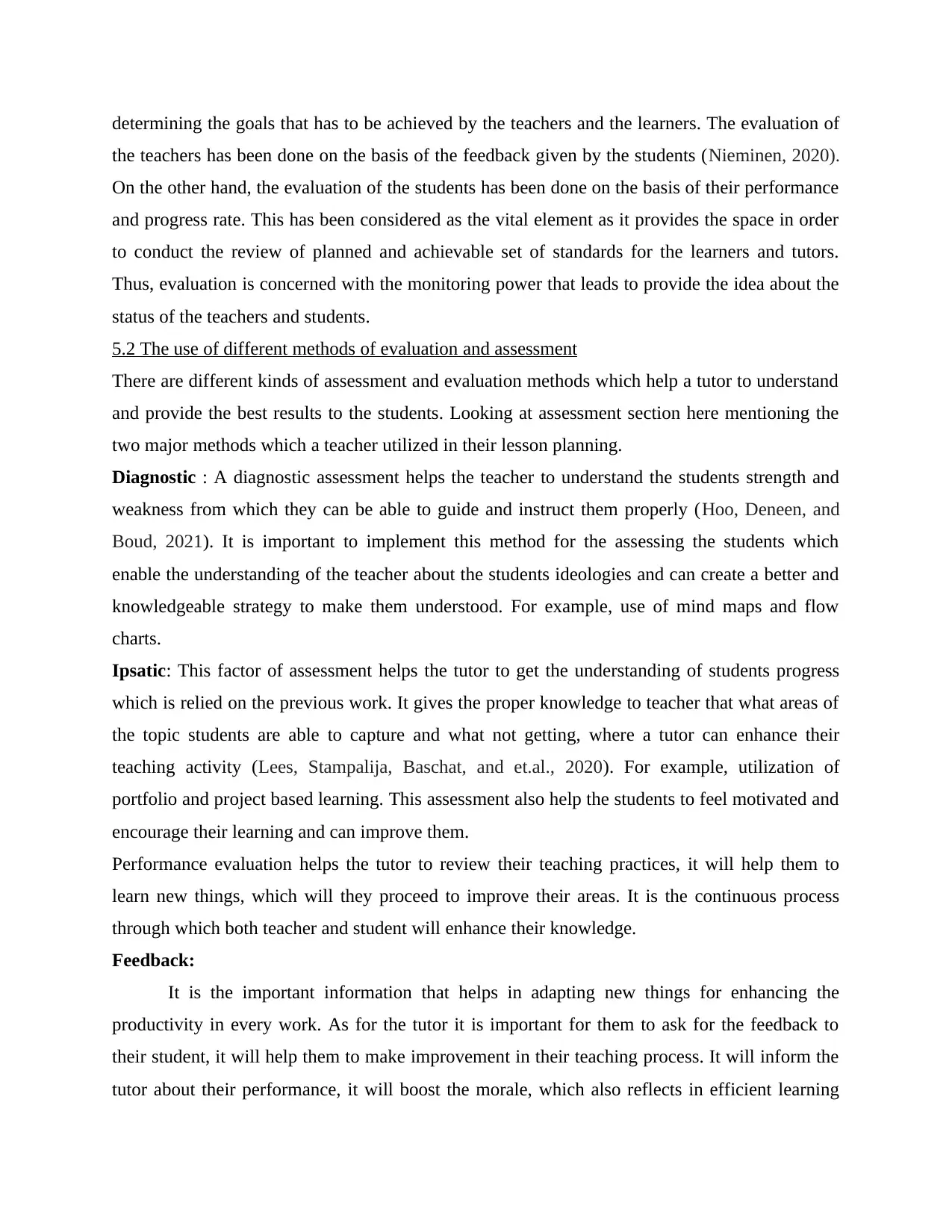
determining the goals that has to be achieved by the teachers and the learners. The evaluation of
the teachers has been done on the basis of the feedback given by the students (Nieminen, 2020).
On the other hand, the evaluation of the students has been done on the basis of their performance
and progress rate. This has been considered as the vital element as it provides the space in order
to conduct the review of planned and achievable set of standards for the learners and tutors.
Thus, evaluation is concerned with the monitoring power that leads to provide the idea about the
status of the teachers and students.
5.2 The use of different methods of evaluation and assessment
There are different kinds of assessment and evaluation methods which help a tutor to understand
and provide the best results to the students. Looking at assessment section here mentioning the
two major methods which a teacher utilized in their lesson planning.
Diagnostic : A diagnostic assessment helps the teacher to understand the students strength and
weakness from which they can be able to guide and instruct them properly (Hoo, Deneen, and
Boud, 2021). It is important to implement this method for the assessing the students which
enable the understanding of the teacher about the students ideologies and can create a better and
knowledgeable strategy to make them understood. For example, use of mind maps and flow
charts.
Ipsatic: This factor of assessment helps the tutor to get the understanding of students progress
which is relied on the previous work. It gives the proper knowledge to teacher that what areas of
the topic students are able to capture and what not getting, where a tutor can enhance their
teaching activity (Lees, Stampalija, Baschat, and et.al., 2020). For example, utilization of
portfolio and project based learning. This assessment also help the students to feel motivated and
encourage their learning and can improve them.
Performance evaluation helps the tutor to review their teaching practices, it will help them to
learn new things, which will they proceed to improve their areas. It is the continuous process
through which both teacher and student will enhance their knowledge.
Feedback:
It is the important information that helps in adapting new things for enhancing the
productivity in every work. As for the tutor it is important for them to ask for the feedback to
their student, it will help them to make improvement in their teaching process. It will inform the
tutor about their performance, it will boost the morale, which also reflects in efficient learning
the teachers has been done on the basis of the feedback given by the students (Nieminen, 2020).
On the other hand, the evaluation of the students has been done on the basis of their performance
and progress rate. This has been considered as the vital element as it provides the space in order
to conduct the review of planned and achievable set of standards for the learners and tutors.
Thus, evaluation is concerned with the monitoring power that leads to provide the idea about the
status of the teachers and students.
5.2 The use of different methods of evaluation and assessment
There are different kinds of assessment and evaluation methods which help a tutor to understand
and provide the best results to the students. Looking at assessment section here mentioning the
two major methods which a teacher utilized in their lesson planning.
Diagnostic : A diagnostic assessment helps the teacher to understand the students strength and
weakness from which they can be able to guide and instruct them properly (Hoo, Deneen, and
Boud, 2021). It is important to implement this method for the assessing the students which
enable the understanding of the teacher about the students ideologies and can create a better and
knowledgeable strategy to make them understood. For example, use of mind maps and flow
charts.
Ipsatic: This factor of assessment helps the tutor to get the understanding of students progress
which is relied on the previous work. It gives the proper knowledge to teacher that what areas of
the topic students are able to capture and what not getting, where a tutor can enhance their
teaching activity (Lees, Stampalija, Baschat, and et.al., 2020). For example, utilization of
portfolio and project based learning. This assessment also help the students to feel motivated and
encourage their learning and can improve them.
Performance evaluation helps the tutor to review their teaching practices, it will help them to
learn new things, which will they proceed to improve their areas. It is the continuous process
through which both teacher and student will enhance their knowledge.
Feedback:
It is the important information that helps in adapting new things for enhancing the
productivity in every work. As for the tutor it is important for them to ask for the feedback to
their student, it will help them to make improvement in their teaching process. It will inform the
tutor about their performance, it will boost the morale, which also reflects in efficient learning
Paraphrase This Document
Need a fresh take? Get an instant paraphrase of this document with our AI Paraphraser
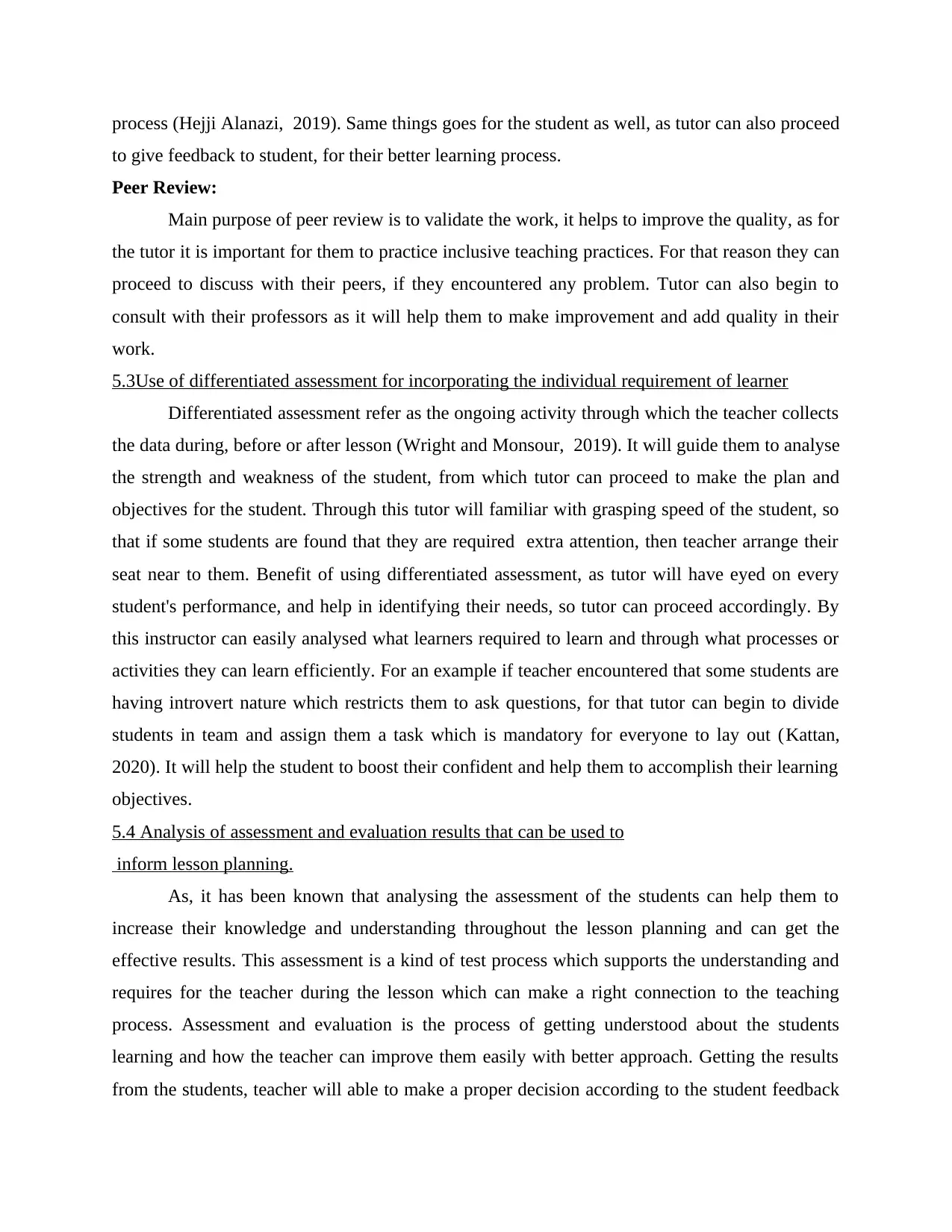
process (Hejji Alanazi, 2019). Same things goes for the student as well, as tutor can also proceed
to give feedback to student, for their better learning process.
Peer Review:
Main purpose of peer review is to validate the work, it helps to improve the quality, as for
the tutor it is important for them to practice inclusive teaching practices. For that reason they can
proceed to discuss with their peers, if they encountered any problem. Tutor can also begin to
consult with their professors as it will help them to make improvement and add quality in their
work.
5.3Use of differentiated assessment for incorporating the individual requirement of learner
Differentiated assessment refer as the ongoing activity through which the teacher collects
the data during, before or after lesson (Wright and Monsour, 2019). It will guide them to analyse
the strength and weakness of the student, from which tutor can proceed to make the plan and
objectives for the student. Through this tutor will familiar with grasping speed of the student, so
that if some students are found that they are required extra attention, then teacher arrange their
seat near to them. Benefit of using differentiated assessment, as tutor will have eyed on every
student's performance, and help in identifying their needs, so tutor can proceed accordingly. By
this instructor can easily analysed what learners required to learn and through what processes or
activities they can learn efficiently. For an example if teacher encountered that some students are
having introvert nature which restricts them to ask questions, for that tutor can begin to divide
students in team and assign them a task which is mandatory for everyone to lay out (Kattan,
2020). It will help the student to boost their confident and help them to accomplish their learning
objectives.
5.4 Analysis of assessment and evaluation results that can be used to
inform lesson planning.
As, it has been known that analysing the assessment of the students can help them to
increase their knowledge and understanding throughout the lesson planning and can get the
effective results. This assessment is a kind of test process which supports the understanding and
requires for the teacher during the lesson which can make a right connection to the teaching
process. Assessment and evaluation is the process of getting understood about the students
learning and how the teacher can improve them easily with better approach. Getting the results
from the students, teacher will able to make a proper decision according to the student feedback
to give feedback to student, for their better learning process.
Peer Review:
Main purpose of peer review is to validate the work, it helps to improve the quality, as for
the tutor it is important for them to practice inclusive teaching practices. For that reason they can
proceed to discuss with their peers, if they encountered any problem. Tutor can also begin to
consult with their professors as it will help them to make improvement and add quality in their
work.
5.3Use of differentiated assessment for incorporating the individual requirement of learner
Differentiated assessment refer as the ongoing activity through which the teacher collects
the data during, before or after lesson (Wright and Monsour, 2019). It will guide them to analyse
the strength and weakness of the student, from which tutor can proceed to make the plan and
objectives for the student. Through this tutor will familiar with grasping speed of the student, so
that if some students are found that they are required extra attention, then teacher arrange their
seat near to them. Benefit of using differentiated assessment, as tutor will have eyed on every
student's performance, and help in identifying their needs, so tutor can proceed accordingly. By
this instructor can easily analysed what learners required to learn and through what processes or
activities they can learn efficiently. For an example if teacher encountered that some students are
having introvert nature which restricts them to ask questions, for that tutor can begin to divide
students in team and assign them a task which is mandatory for everyone to lay out (Kattan,
2020). It will help the student to boost their confident and help them to accomplish their learning
objectives.
5.4 Analysis of assessment and evaluation results that can be used to
inform lesson planning.
As, it has been known that analysing the assessment of the students can help them to
increase their knowledge and understanding throughout the lesson planning and can get the
effective results. This assessment is a kind of test process which supports the understanding and
requires for the teacher during the lesson which can make a right connection to the teaching
process. Assessment and evaluation is the process of getting understood about the students
learning and how the teacher can improve them easily with better approach. Getting the results
from the students, teacher will able to make a proper decision according to the student feedback
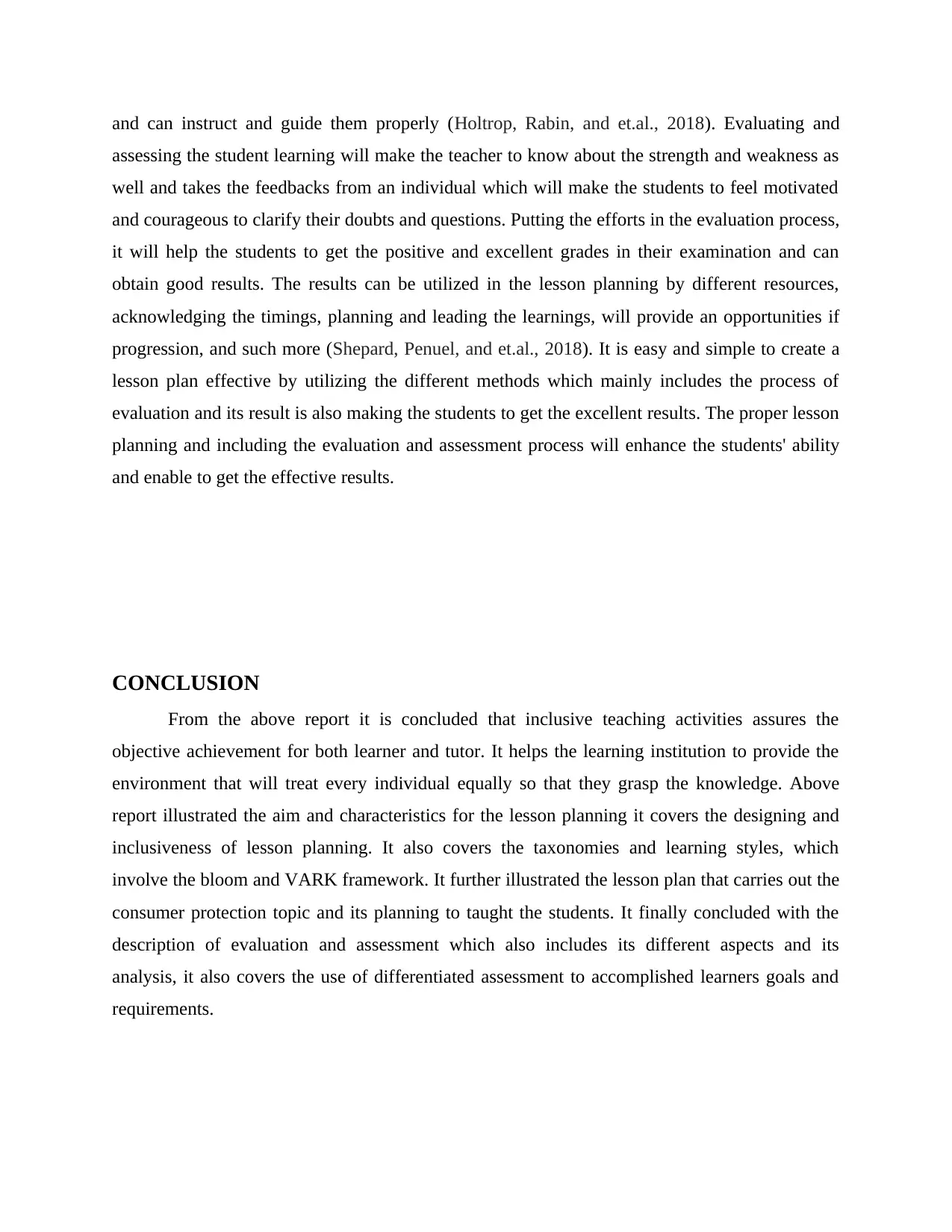
and can instruct and guide them properly (Holtrop, Rabin, and et.al., 2018). Evaluating and
assessing the student learning will make the teacher to know about the strength and weakness as
well and takes the feedbacks from an individual which will make the students to feel motivated
and courageous to clarify their doubts and questions. Putting the efforts in the evaluation process,
it will help the students to get the positive and excellent grades in their examination and can
obtain good results. The results can be utilized in the lesson planning by different resources,
acknowledging the timings, planning and leading the learnings, will provide an opportunities if
progression, and such more (Shepard, Penuel, and et.al., 2018). It is easy and simple to create a
lesson plan effective by utilizing the different methods which mainly includes the process of
evaluation and its result is also making the students to get the excellent results. The proper lesson
planning and including the evaluation and assessment process will enhance the students' ability
and enable to get the effective results.
CONCLUSION
From the above report it is concluded that inclusive teaching activities assures the
objective achievement for both learner and tutor. It helps the learning institution to provide the
environment that will treat every individual equally so that they grasp the knowledge. Above
report illustrated the aim and characteristics for the lesson planning it covers the designing and
inclusiveness of lesson planning. It also covers the taxonomies and learning styles, which
involve the bloom and VARK framework. It further illustrated the lesson plan that carries out the
consumer protection topic and its planning to taught the students. It finally concluded with the
description of evaluation and assessment which also includes its different aspects and its
analysis, it also covers the use of differentiated assessment to accomplished learners goals and
requirements.
assessing the student learning will make the teacher to know about the strength and weakness as
well and takes the feedbacks from an individual which will make the students to feel motivated
and courageous to clarify their doubts and questions. Putting the efforts in the evaluation process,
it will help the students to get the positive and excellent grades in their examination and can
obtain good results. The results can be utilized in the lesson planning by different resources,
acknowledging the timings, planning and leading the learnings, will provide an opportunities if
progression, and such more (Shepard, Penuel, and et.al., 2018). It is easy and simple to create a
lesson plan effective by utilizing the different methods which mainly includes the process of
evaluation and its result is also making the students to get the excellent results. The proper lesson
planning and including the evaluation and assessment process will enhance the students' ability
and enable to get the effective results.
CONCLUSION
From the above report it is concluded that inclusive teaching activities assures the
objective achievement for both learner and tutor. It helps the learning institution to provide the
environment that will treat every individual equally so that they grasp the knowledge. Above
report illustrated the aim and characteristics for the lesson planning it covers the designing and
inclusiveness of lesson planning. It also covers the taxonomies and learning styles, which
involve the bloom and VARK framework. It further illustrated the lesson plan that carries out the
consumer protection topic and its planning to taught the students. It finally concluded with the
description of evaluation and assessment which also includes its different aspects and its
analysis, it also covers the use of differentiated assessment to accomplished learners goals and
requirements.

REFERENCES
Books and Journals
Adom, D., Mensah, J.A. and Dake, D.A., 2020. Test, Measurement, and Evaluation:
Understanding and Use of the Concepts in Education. International Journal of
Evaluation and Research in Education. 9(1). pp.109-119.
Boussakssou, M., Hssina, B. and Erittali, M., 2020. Towards an adaptive E-learning system
based on Q-learning algorithm. Procedia Computer Science. 170. pp.1198-1203.
Cosgrove, R., 2020. Inclusive Teaching in a Nutshell: A Visual Guide for Busy Teachers.
Routledge.
Ellano, L.B., 2019. WHY LESSON PLANNING IS IMPORTANT.
Gallardo, K., 2020. Competency-based assessment and the use of performance-based evaluation
rubrics in higher education: Challenges towards the next decade. Problems of Education
in the 21st Century. 78(1). pp.61-79.
Hamzah, A.A. and Shamsudin, M.F., 2020. Why customer satisfaction is important to
business?. Journal of Undergraduate Social Science and Technology. 1(1).
Hejji Alanazi, M., 2019. A study of the pre-service trainee teachers problems in designing lesson
plans. Arab World English Journal (AWEJ) Volume, 10.
Holtrop, J.S., Rabin, B.A. and et.al., 2018. Qualitative approaches to use of the RE-AIM
framework: rationale and methods. BMC health services research. 18(1), pp.1-10.
Hoo, H.T., Deneen, C. and Boud, D., 2021. Developing student feedback literacy through self
and peer assessment interventions. Assessment & Evaluation in Higher Education. pp.1-
14.
Books and Journals
Adom, D., Mensah, J.A. and Dake, D.A., 2020. Test, Measurement, and Evaluation:
Understanding and Use of the Concepts in Education. International Journal of
Evaluation and Research in Education. 9(1). pp.109-119.
Boussakssou, M., Hssina, B. and Erittali, M., 2020. Towards an adaptive E-learning system
based on Q-learning algorithm. Procedia Computer Science. 170. pp.1198-1203.
Cosgrove, R., 2020. Inclusive Teaching in a Nutshell: A Visual Guide for Busy Teachers.
Routledge.
Ellano, L.B., 2019. WHY LESSON PLANNING IS IMPORTANT.
Gallardo, K., 2020. Competency-based assessment and the use of performance-based evaluation
rubrics in higher education: Challenges towards the next decade. Problems of Education
in the 21st Century. 78(1). pp.61-79.
Hamzah, A.A. and Shamsudin, M.F., 2020. Why customer satisfaction is important to
business?. Journal of Undergraduate Social Science and Technology. 1(1).
Hejji Alanazi, M., 2019. A study of the pre-service trainee teachers problems in designing lesson
plans. Arab World English Journal (AWEJ) Volume, 10.
Holtrop, J.S., Rabin, B.A. and et.al., 2018. Qualitative approaches to use of the RE-AIM
framework: rationale and methods. BMC health services research. 18(1), pp.1-10.
Hoo, H.T., Deneen, C. and Boud, D., 2021. Developing student feedback literacy through self
and peer assessment interventions. Assessment & Evaluation in Higher Education. pp.1-
14.
Secure Best Marks with AI Grader
Need help grading? Try our AI Grader for instant feedback on your assignments.
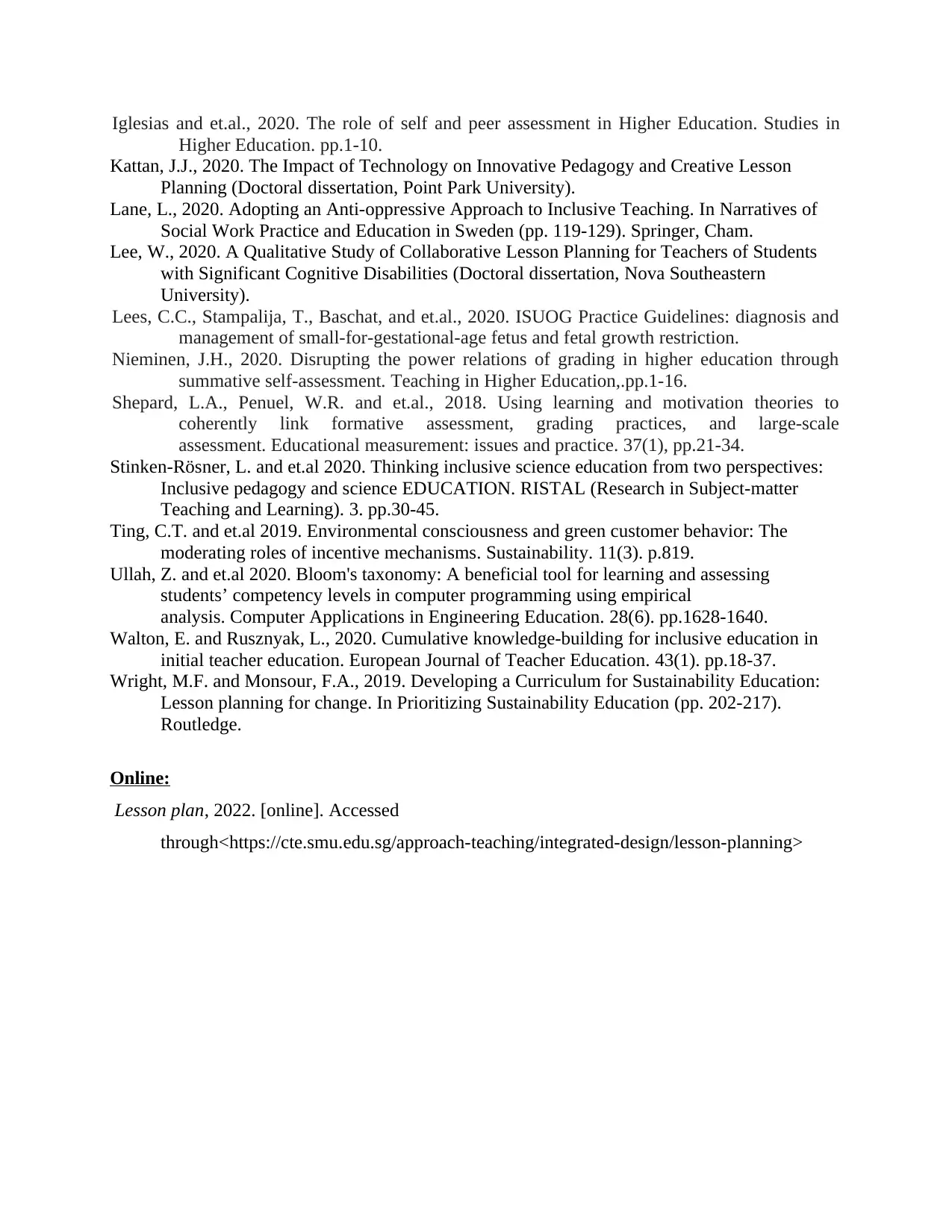
Iglesias and et.al., 2020. The role of self and peer assessment in Higher Education. Studies in
Higher Education. pp.1-10.
Kattan, J.J., 2020. The Impact of Technology on Innovative Pedagogy and Creative Lesson
Planning (Doctoral dissertation, Point Park University).
Lane, L., 2020. Adopting an Anti-oppressive Approach to Inclusive Teaching. In Narratives of
Social Work Practice and Education in Sweden (pp. 119-129). Springer, Cham.
Lee, W., 2020. A Qualitative Study of Collaborative Lesson Planning for Teachers of Students
with Significant Cognitive Disabilities (Doctoral dissertation, Nova Southeastern
University).
Lees, C.C., Stampalija, T., Baschat, and et.al., 2020. ISUOG Practice Guidelines: diagnosis and
management of small-for-gestational-age fetus and fetal growth restriction.
Nieminen, J.H., 2020. Disrupting the power relations of grading in higher education through
summative self-assessment. Teaching in Higher Education,.pp.1-16.
Shepard, L.A., Penuel, W.R. and et.al., 2018. Using learning and motivation theories to
coherently link formative assessment, grading practices, and large‐scale
assessment. Educational measurement: issues and practice. 37(1), pp.21-34.
Stinken-Rösner, L. and et.al 2020. Thinking inclusive science education from two perspectives:
Inclusive pedagogy and science EDUCATION. RISTAL (Research in Subject-matter
Teaching and Learning). 3. pp.30-45.
Ting, C.T. and et.al 2019. Environmental consciousness and green customer behavior: The
moderating roles of incentive mechanisms. Sustainability. 11(3). p.819.
Ullah, Z. and et.al 2020. Bloom's taxonomy: A beneficial tool for learning and assessing
students’ competency levels in computer programming using empirical
analysis. Computer Applications in Engineering Education. 28(6). pp.1628-1640.
Walton, E. and Rusznyak, L., 2020. Cumulative knowledge-building for inclusive education in
initial teacher education. European Journal of Teacher Education. 43(1). pp.18-37.
Wright, M.F. and Monsour, F.A., 2019. Developing a Curriculum for Sustainability Education:
Lesson planning for change. In Prioritizing Sustainability Education (pp. 202-217).
Routledge.
Online:
Lesson plan, 2022. [online]. Accessed
through<https://cte.smu.edu.sg/approach-teaching/integrated-design/lesson-planning>
Higher Education. pp.1-10.
Kattan, J.J., 2020. The Impact of Technology on Innovative Pedagogy and Creative Lesson
Planning (Doctoral dissertation, Point Park University).
Lane, L., 2020. Adopting an Anti-oppressive Approach to Inclusive Teaching. In Narratives of
Social Work Practice and Education in Sweden (pp. 119-129). Springer, Cham.
Lee, W., 2020. A Qualitative Study of Collaborative Lesson Planning for Teachers of Students
with Significant Cognitive Disabilities (Doctoral dissertation, Nova Southeastern
University).
Lees, C.C., Stampalija, T., Baschat, and et.al., 2020. ISUOG Practice Guidelines: diagnosis and
management of small-for-gestational-age fetus and fetal growth restriction.
Nieminen, J.H., 2020. Disrupting the power relations of grading in higher education through
summative self-assessment. Teaching in Higher Education,.pp.1-16.
Shepard, L.A., Penuel, W.R. and et.al., 2018. Using learning and motivation theories to
coherently link formative assessment, grading practices, and large‐scale
assessment. Educational measurement: issues and practice. 37(1), pp.21-34.
Stinken-Rösner, L. and et.al 2020. Thinking inclusive science education from two perspectives:
Inclusive pedagogy and science EDUCATION. RISTAL (Research in Subject-matter
Teaching and Learning). 3. pp.30-45.
Ting, C.T. and et.al 2019. Environmental consciousness and green customer behavior: The
moderating roles of incentive mechanisms. Sustainability. 11(3). p.819.
Ullah, Z. and et.al 2020. Bloom's taxonomy: A beneficial tool for learning and assessing
students’ competency levels in computer programming using empirical
analysis. Computer Applications in Engineering Education. 28(6). pp.1628-1640.
Walton, E. and Rusznyak, L., 2020. Cumulative knowledge-building for inclusive education in
initial teacher education. European Journal of Teacher Education. 43(1). pp.18-37.
Wright, M.F. and Monsour, F.A., 2019. Developing a Curriculum for Sustainability Education:
Lesson planning for change. In Prioritizing Sustainability Education (pp. 202-217).
Routledge.
Online:
Lesson plan, 2022. [online]. Accessed
through<https://cte.smu.edu.sg/approach-teaching/integrated-design/lesson-planning>
1 out of 20
Related Documents
Your All-in-One AI-Powered Toolkit for Academic Success.
+13062052269
info@desklib.com
Available 24*7 on WhatsApp / Email
![[object Object]](/_next/static/media/star-bottom.7253800d.svg)
Unlock your academic potential
© 2024 | Zucol Services PVT LTD | All rights reserved.




